We Tested the 11 Best (& Underrated) AI SEO Tools in 2025
SEO isn’t dead in 2025, but it’s definitely different.
It’s not just about ranking on Google anymore, but also about showing up on AI search engines and LLMs like ChatGPT and Perplexity.
The way we do SEO has also changed. There are now tons of exciting new tools, powered by AI, that can help you deliver better results—faster—for your clients or your brand.

Oct 06 2025●10 min read
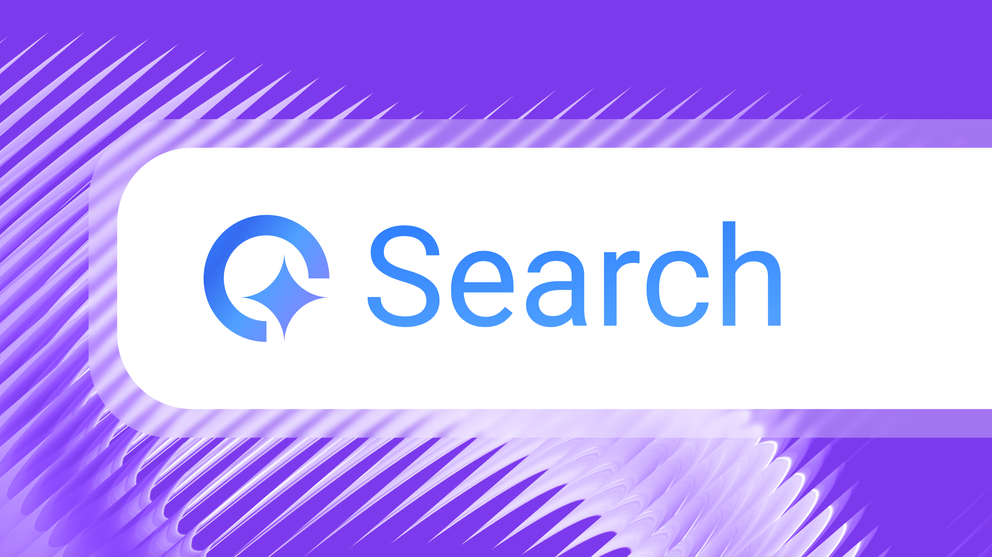
But not every tool that slaps “AI” on the label is worth your budget.
Some are little more than glorified content spinners, while others lack the stability or data quality.
The best ones integrate seamlessly into existing workflows, speed up repetitive tasks, and give your team more time to focus on strategy.
This guide cuts through the noise and highlights the AI SEO tools that actually deliver results, whether you're doing AI SEO optimization, automating reporting, or scaling campaigns across multiple brands.
How I Chose AI SEO Tools
SEO is very close to my heart.
I spent 3 years as Head of Content at an SEO agency, and now as Senior Content Marketing Manager at Whatagraph, SEO is our most important channel for bringing in MQLs and ICP leads.
So, I didn’t want this article to be just another roundup of the same tools you’ve seen a dozen times.
I wanted you to discover underrated AI SEO software that:
- Agencies and SEO strategists are actually using right now
- Excel in specific, niche use cases
Here’s how I picked them:
1. I asked SEO strategists what tools they recommend.
I asked SEO strategists on LinkedIn what AI tools they’re using every day and what they love about them—and got dozens of honest, unsponsored replies.
But I also mined through all these recommendations and picked just the tools that are either powered by AI, or lets you do something with AI.
2. I tested most of them myself or interviewed others who are currently using them.
Unless noted otherwise, I’ve personally tried these AI-powered SEO tools. If they didn’t deliver real value or improve our workflow, they didn’t make the cut. If I didn't test a tool myself, I included quotes from others who have.
3. I checked for agency-friendly pricing.
For agencies trying to scale, predictable pricing is non-negotiable, especially when onboarding new clients or building internal processes around a platform. I scoured the latest pricing details of each tool and included them in detail wherever possible.
That being said, here’s a summary of the SEO AI tools I'll review:
Tool Name | Best For | Pricing Summary |
| Writesonic | Speeding up SEO research and content creation with real-time SEO data | From $16/month. Tiered plans based on users/projects. Free trial available. |
| AirOps | Automating SEO ops and content production with flexible workflows | Free starter plan. Custom pricing for Scale and Agency plans. |
| Clearscope | Optimizing human-written content for SEO that ranks fast and well | Starts at $189/month. Scales with usage and features. |
| Ahrefs AI Content Helper | Optimizing for real search intent using AI, built into Ahrefs suite | Starts at $129/month. Included in Ahrefs subscription plans. |
| Rankscale.ai | Tracking brand visibility in AI search engines by keyword, engine, and region | Starts at $20 (credit-based). No subscription needed. |
| Whatagraph | Creating beautiful, accurate SEO reports for clients and leadership | All-inclusive pricing. Based on source credits. No hidden fees. |
| DataForSEO | Pulling real-time SEO data at scale to power custom tools and dashboards | Pay-as-you-go. Minimum $50 to start. Pricing varies by API usage. |
| Pitchbox | Automating backlink outreach with smart personalization and tracking | From $165/month. Scales by users and features. |
| Ranking Raccoon | Exchanging backlinks with vetted websites through a moderated community | Free plan available. Pro version is $25/month. |
| Indexly | Automating indexing so pages show up in search faster | Free plan available. Paid plans from $14/month. |
| SE Ranking (AI Tracker) | Tracking Google AI Overview presence and comparing with organic rankings | Starts at $95.20/month (annual). AI tracker included in Pro and Business plans. |
Important note: We do not get any commissions from these tools featured. We chose them purely based on how well they work—not because we’re getting sponsored.
Let’s dig in.
1. Writesonic
Best for: Speeding up SEO research and content creation with real-time data from SEO tools and multi-model AI agent
Writesonic is an all-in-one content creation and AI SEO platform that lets you research, write, optimize, and even publish blog posts—all from one place.
The best thing about Writesonic is Chatsonic, an AI SEO agent where you can ask multiple LLMs—like GPT-4o, o1, Claude, Gemini, and Flux 1.1—to do SEO tasks with real-time data streaming in from your SEO tools.
For instance, Evelina Milenova, SEO and Growth Manager at Opinion Stage, used Chatsonic to review one of their best-converting pages ranking in the middle of page 1.
Chatsonic pulled insights from multiple data sources including Google Search Console, Semrush, Ahrefs, and Keywords Everywhere, and gave specific and actionable tips to improve their content:
- Identified missing alt text across key images that could be hurting SEO
- Flagged missed keyword opportunities in headers like the H1 and H2s
- Suggested a new content structure optimized for better readability and engagement
You can find the full breakdown in her LinkedIn post:
Evelina raved about Chatsonic:
LLMs like ChatGPT provide generic advice that doesn't consider what's already on the page. But Chatsonic identified real areas for improvement and concrete suggestions—it felt like collaborating with another SEO expert on the team!
But what about when it comes to AI writing?
Writesonic generously gave us free trial access to try out their AI writer, and I opted for the “10-step AI article writer” to have full control over the content generation process:
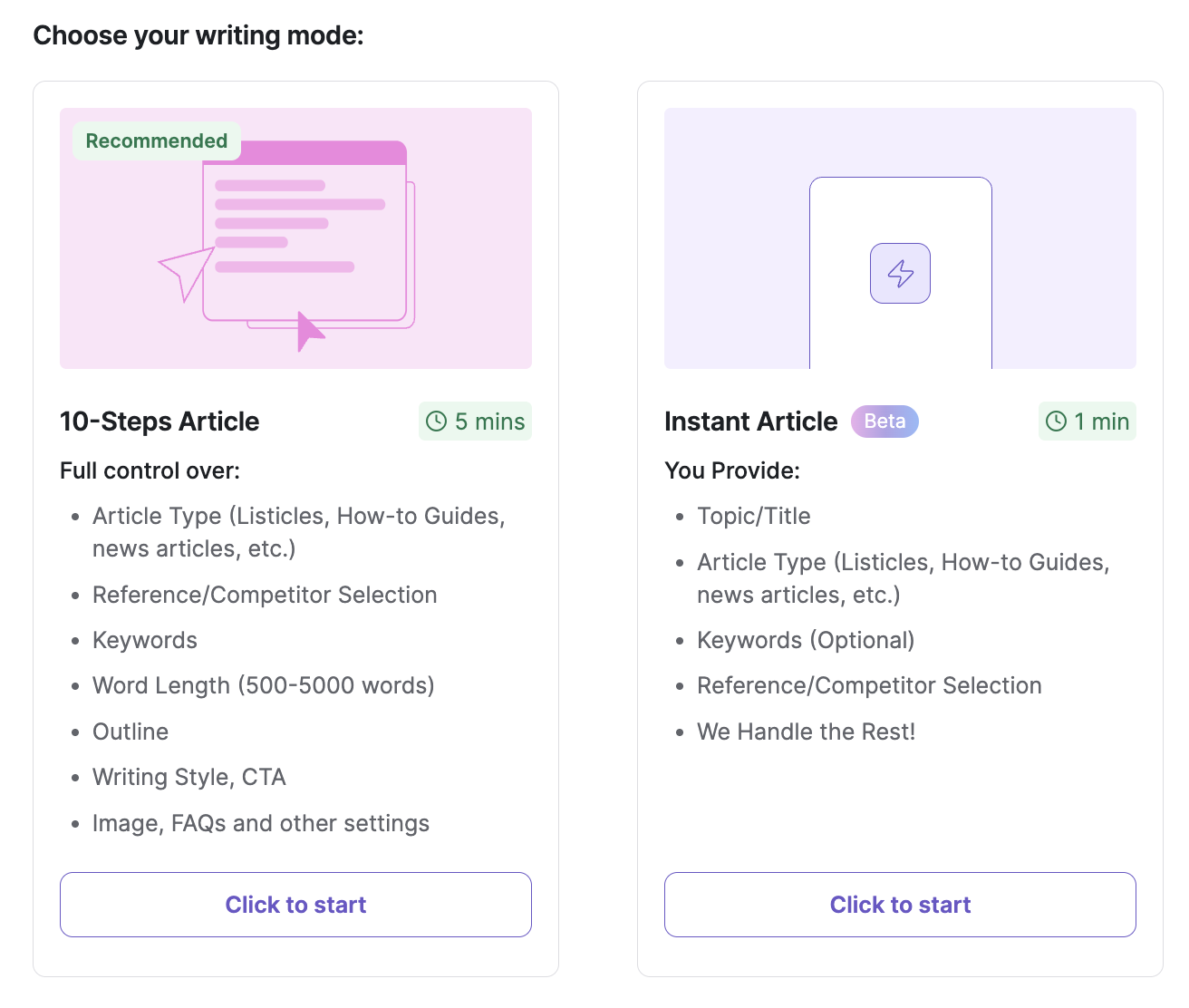 To be “meta”, I decided to generate an AI article for this exact article I’m writing: AI SEO tools. This is what the process looked like:
To be “meta”, I decided to generate an AI article for this exact article I’m writing: AI SEO tools. This is what the process looked like:
How Writesonic’s AI writer works
1. Set your topic
I started by choosing a topic (like “AI tools for SEO”). I could either pick from suggested ideas or enter my own. I also selected the audience location and language to tailor the content accordingly.
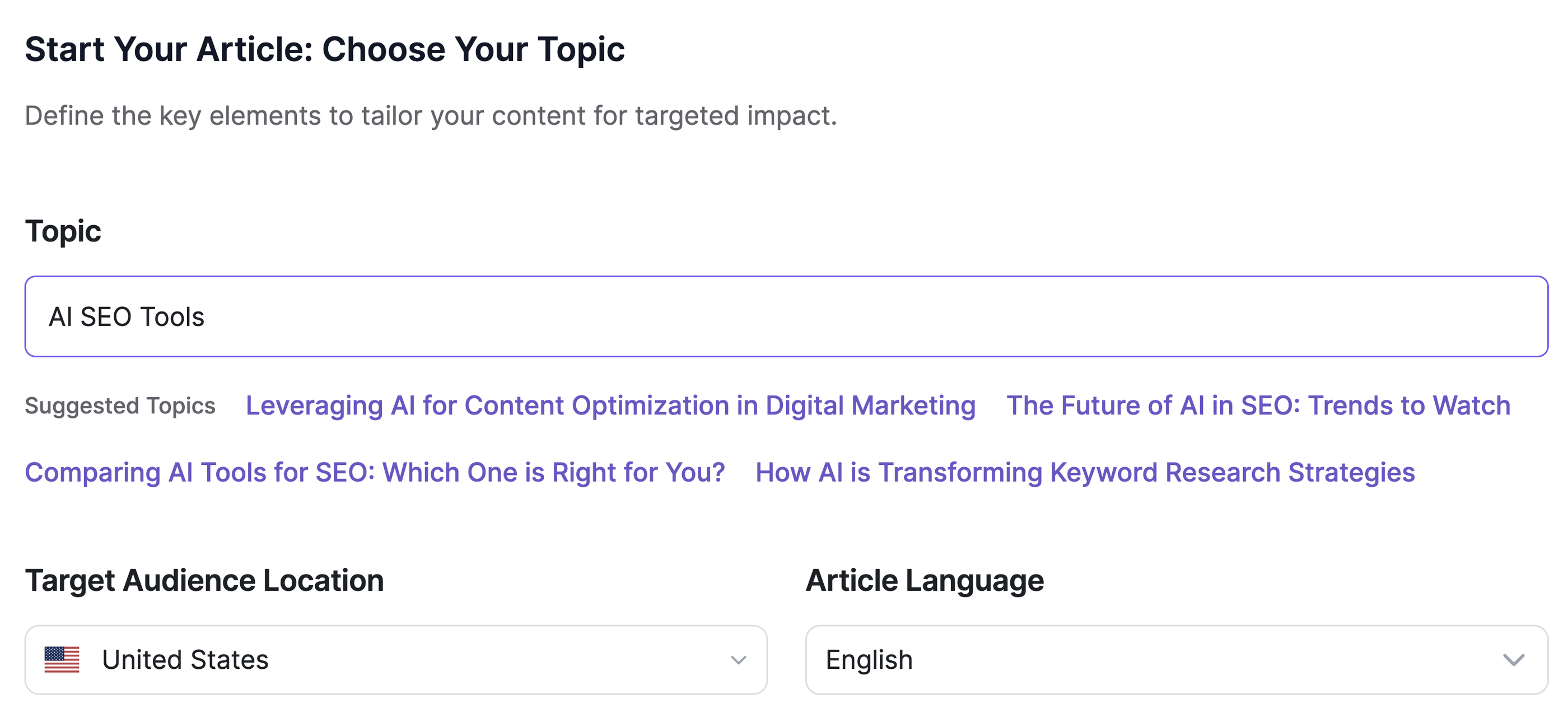 2. Select your article type and research method
2. Select your article type and research method
Next, I chose the format—like a blog post, listicle, or product roundup—and decided whether to pull live web insights or use custom sources like PDFs, internal docs, or brand content.
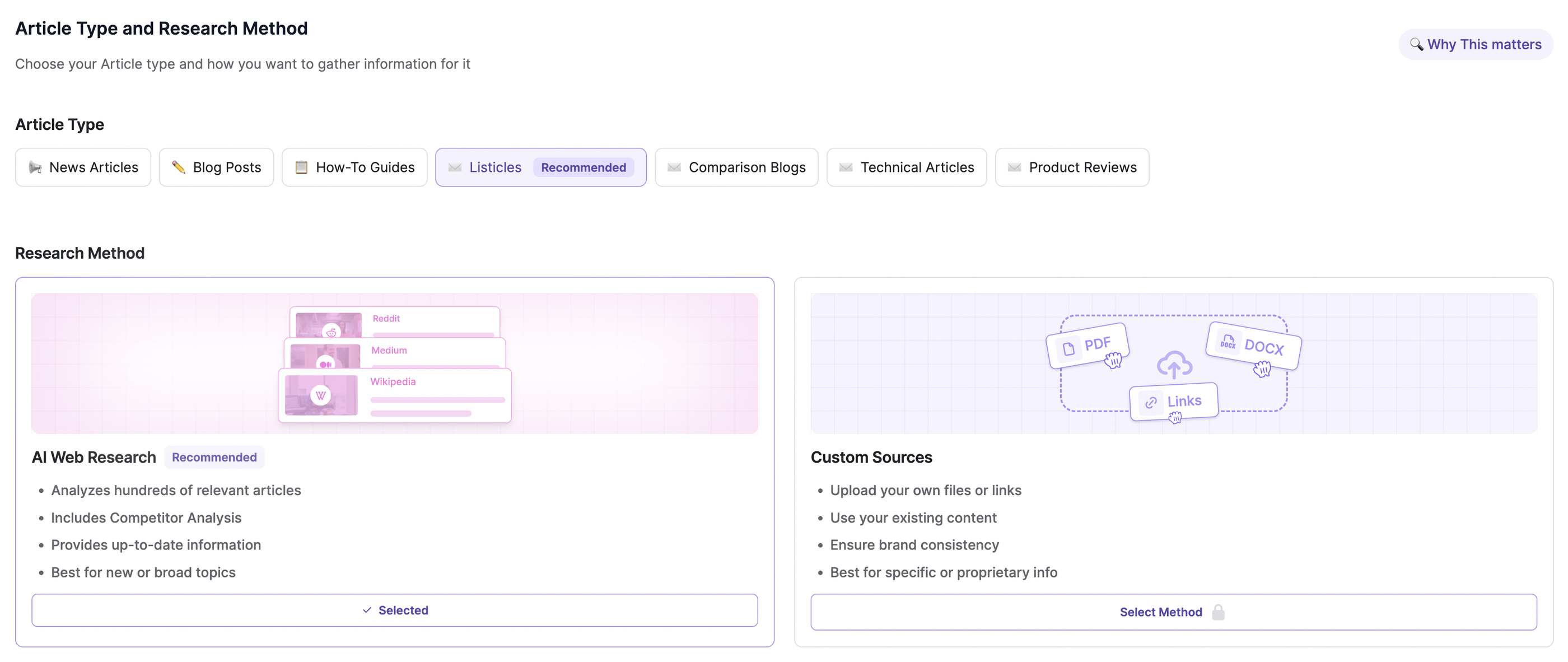 3. Analyze top-performing competitor content
3. Analyze top-performing competitor content
Writesonic recommended top-ranking articles from trusted sources like HubSpot and Backlinko. I picked a few to inform my outline and keyword approach.
 4. Choose primary and secondary keywords
4. Choose primary and secondary keywords
Based on search volume and intent, I selected a primary keyword and added up to 20 secondary keywords to build a strong SEO foundation.
 5. Set your tone and brand voice
5. Set your tone and brand voice
This was a major plus point for me.
On Writesonic, you can upload brand guidelines, past examples, or PDF files to match the writing style to your brand—which is great because I had just recently put together a huge documentation on our brand tone and voice.
If you don’t have one, you can select from pre-set tones like professional, conversational, or casual.
 6. Pick your title and article outline
6. Pick your title and article outline
You can either write your own titles or select from the suggested list.
I wrote my own and selected a content outline that included an intro, breakdowns, and summary. I could adjust the depth of each section based on what I needed.
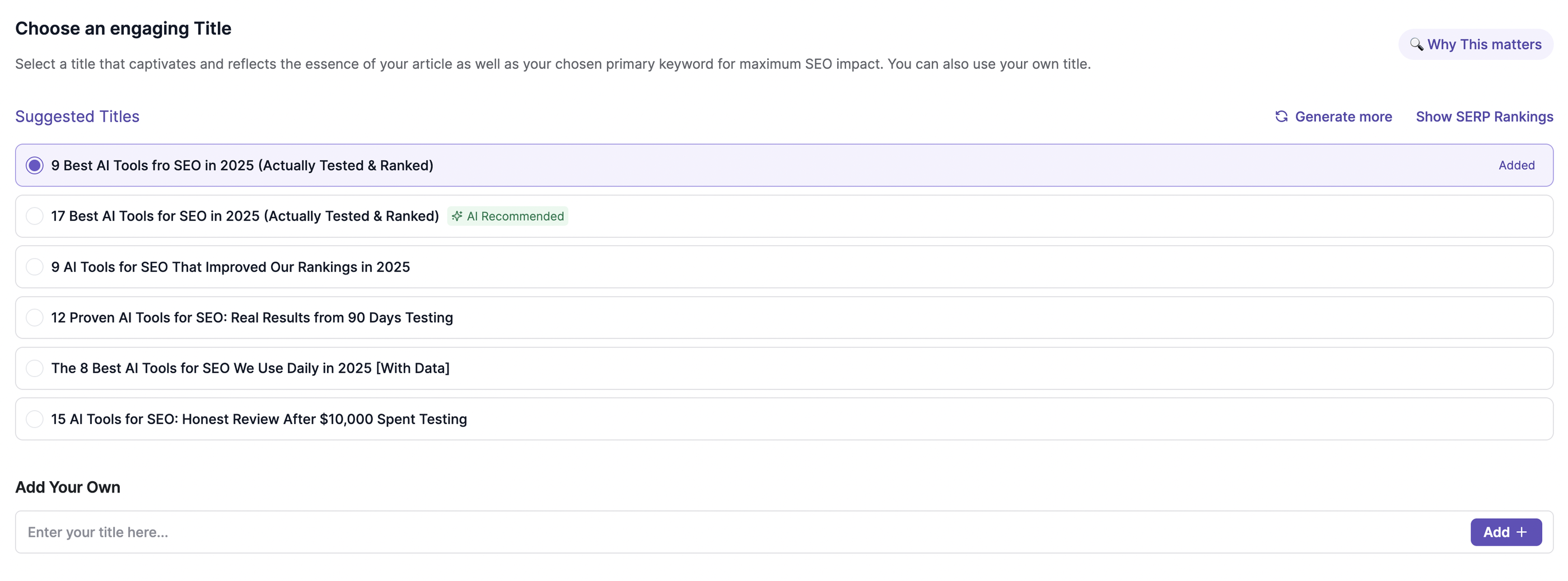 It generated 2 outlines as default based on your title but the tools selected in the listicle were pretty basic – ChatGPT, Semrush, e.t.c – basic tools that people already know.
It generated 2 outlines as default based on your title but the tools selected in the listicle were pretty basic – ChatGPT, Semrush, e.t.c – basic tools that people already know.
You CAN write your own outline but the interface was quite clunky and it kept glitching and the cursor kept going back to the beginning of my sentences.
At one point, I gave up trying to write my own (because it was taking up too much time) and decided to just use one of the outlines.
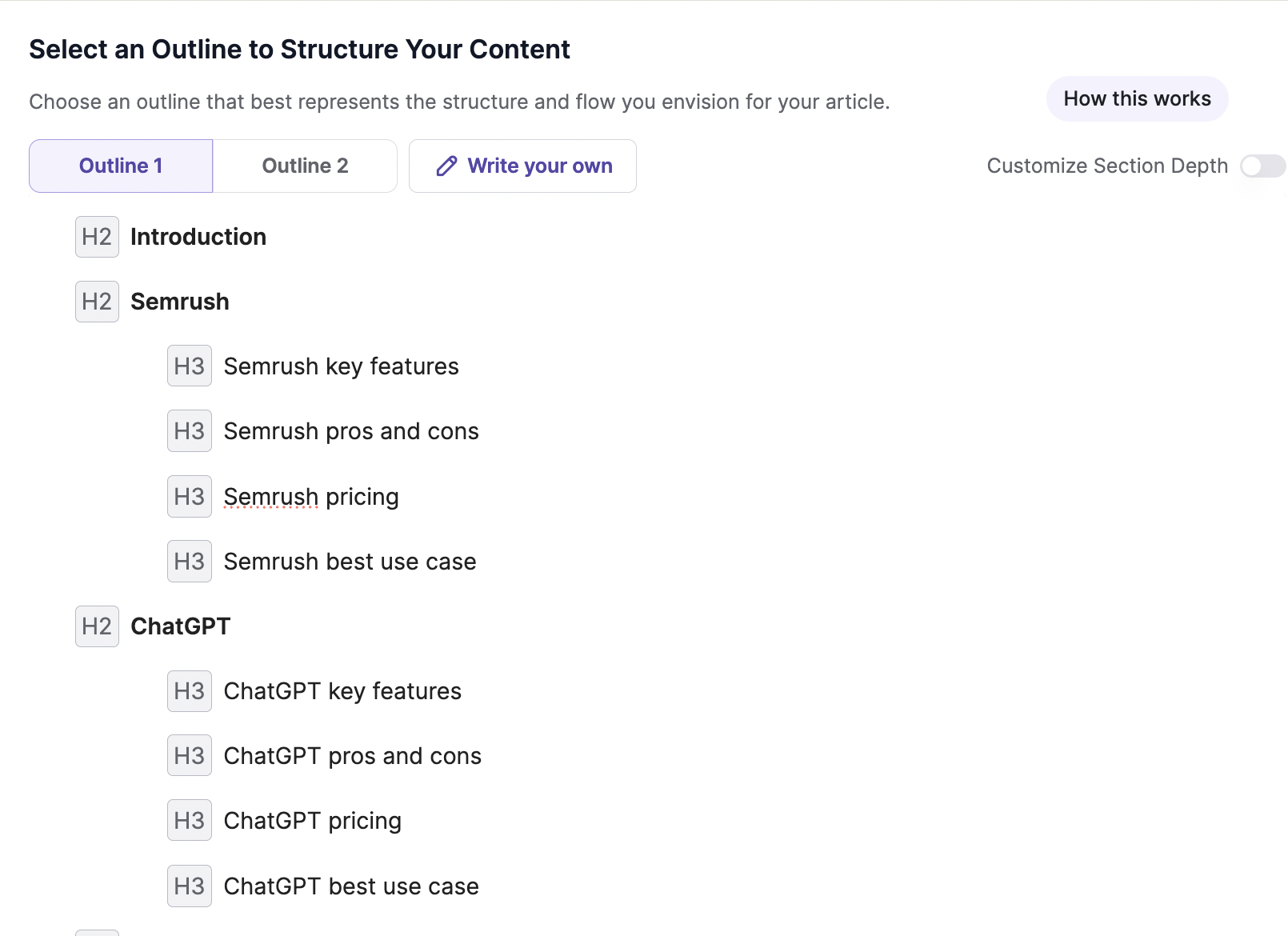 7. Generate the content
7. Generate the content
Once everything was locked in, Writesonic’s AI pulled in the research, applied my keywords and structure, and wrote the article. I could follow progress in real time as it fact-checked and built out the draft.
There is an option to choose an “human” article, but this is locked in the paid plan:
 This writing process took about 10 minutes. And beware—do not press the “back” button or close the tab, because you will need to restart the whole process again (yes from the very beginning). I made that mistake and lost my article on the first try.
This writing process took about 10 minutes. And beware—do not press the “back” button or close the tab, because you will need to restart the whole process again (yes from the very beginning). I made that mistake and lost my article on the first try.
 8. Review, edit, and publish
8. Review, edit, and publish
I got the final article and it was…meh. It looks good on the surface, and gets the facts right (like pricing), but reads bland and monotonous, without much insight into target audience pain points.
You can see from the intro itself:

Even though I had our tone and voice guidelines uploaded, it didn’t capture the tone correctly.
But the good thing is you can add more context around the target audience so it’ll create a more targeted article. And you can also use their Surfy assistant to rephrase or refine copy.
I do like how the content is very factual—you can get it to show you citations. You can also publish this article directly if you use WordPress, which can save you hours of having to upload it yourself.
All in all, Writesonic may not produce perfect content out of the gate, but it might be the most comprehensive and customizable AI content tool right now.
Key features
- Real-time integrations with Ahrefs, Semrush, and Google Search Console
- AI Article Writer using models like GPT-4o and Claude.
- Brand voice customization with uploaded guidelines or sample content
- Real-time SEO optimization suggestions powered by AI
- One-click publishing to WordPress and social media platforms
- Flexible AI generation with access to GPT-4o, Claude, Gemini, and more
Pricing
Writesonic offers flexible plans for individual marketers, SEO pros, and full-service agencies—each with AI agents, SEO tools, and publishing features bundled in.
There is a free trial with limited access to AI tools, 1 site audit (100 pages), and AI traffic analytics.
Otherwise, here are the pricing plans as of May 2025:
Plan | Price (Annual) | Users / Projects | Articles / Month | Site Audits | Key Features |
| Basic | $16/month | 1 user / 1 project | 5 | 3 audits (100 pages each) | 10 AI generations/month |
| Lite | $39/month | 1 user / 1 project | 15 | 6 audits (200 pages each) | 100 AI agent generations, Unlimited Chatsonic, 2 brand voice styles |
| Standard | $79/month | 1 user / 2 projects | 30 | 15 audits (750 pages) | Unlimited AI agents, GA & GSC integration, use your own data, 5 voices |
| Professional | $199/month | 2 users / 3 projects | 100 | 40 audits (1,200 pages) | Brand tracking, Topic Explorer, GEO data, API access |
| Advanced | $399/month | 5 users (up to 10) / 4 projects (expandable to 8) | 200 | 60 audits (2,500 pages) | Full platform access, highest usage limits, scale options |
2. AirOps
Best for: Automating SEO ops and content production from one intuitive and flexible platform
AirOps is a customizable AI content operations platform that helps agencies automate SEO and content workflows at scale.
It combines the power of large language models (like GPT-4, Claude, and Gemini) with flexible templates and integrations—so you can generate high-quality, on-brand content faster, without adding headcount.
Essentially, it’s like building a custom GPT on ChatGPT, but much more powerful and customizable.
Marco Schlauri, Founder at Digital Leverage, an SEO agency based in Switzerland, uses AirOps to automate research and content creation. He said:
We love how easy AirOps is. No coding, no API juggling or maintaining a tool stack. It’s just one intuitive platform with seamless integrations for tools like SEMrush, ChatGPT and Perplexity, plus out-of-the-box solutions for SEO tasks.
Aimee Jurenka, Director of SEO at Rocketship digital marketing agency, even built an automated LLM Brand Audit workflow on AirOps to identify content gaps.
And if you don’t want to build from scratch, AirOps also provides done-for-you templates based on SEO best practices.
I decided to try it out and here’s how it went:
How AirOps works
When you create an account, AirOps will ask you to name the project and add the URL of the project. Based on this URL, it’ll automatically generate a “Brand Kit” for you, which you can fully edit.
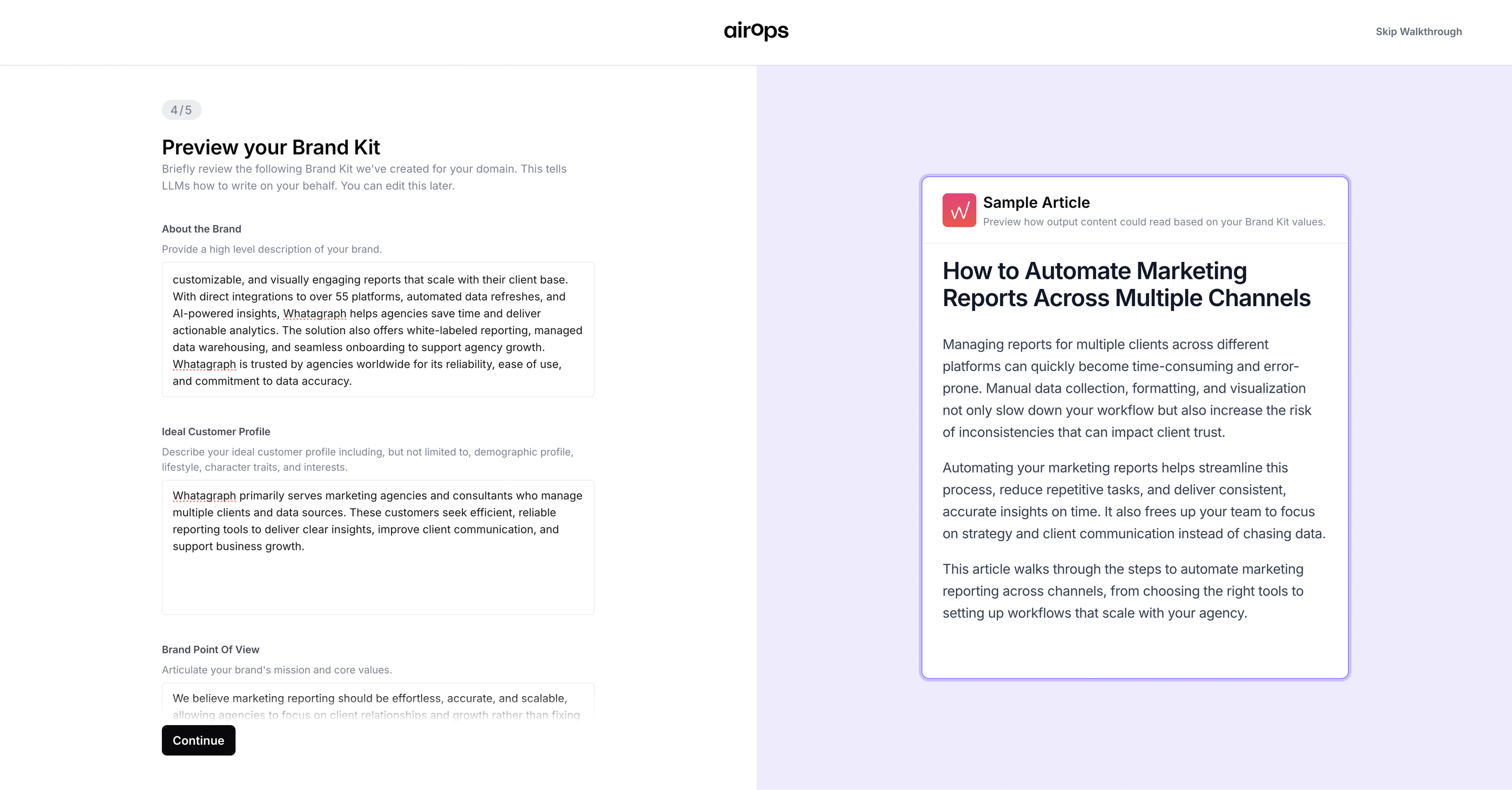
I personally loved the option to add your brand’s point of view, since we know this is what matters the most to stand out.
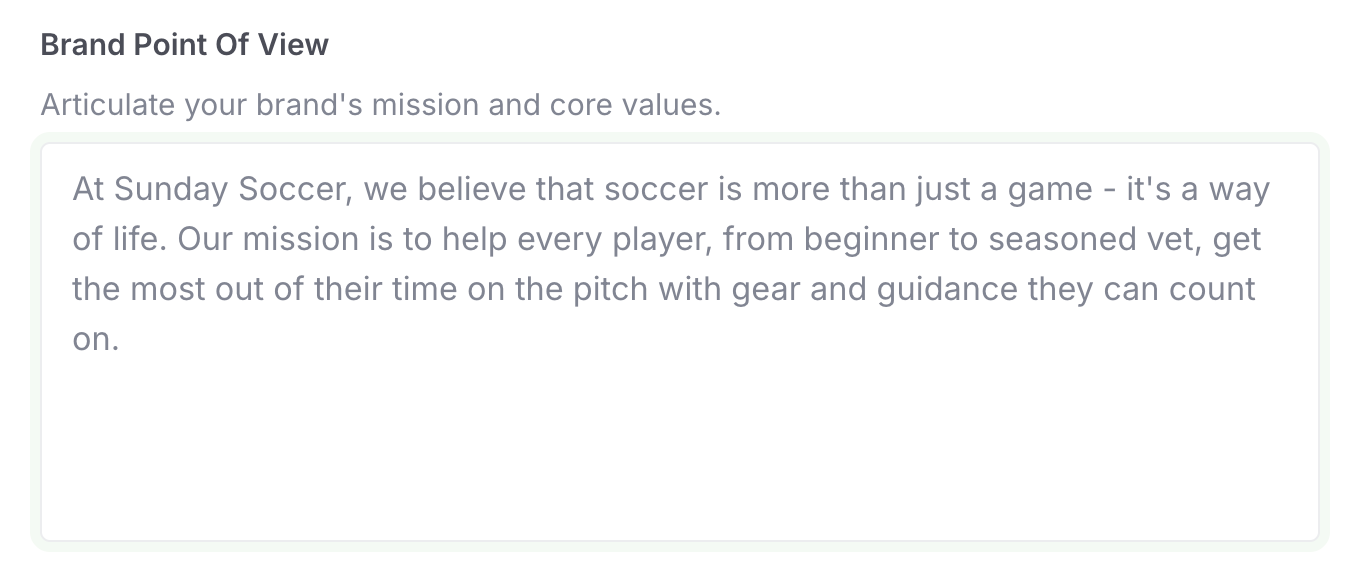 From there, you can either start with a template or build your own workflows. Here’s what you can automate:
From there, you can either start with a template or build your own workflows. Here’s what you can automate:
- Content briefs: Pulls in live SEO data to build structured, keyword-rich briefs your writers can use right away.
- Long-form articles: Generates long-form content with your brand voice baked in. You control tone, structure, and sources.
- Internal/external linking: Automates linking between your content pieces, based on semantic relevance and performance.
I decided to try out the content brief template and I was taken to a spreadsheet where I could add the topic I wanted to create the brief for.
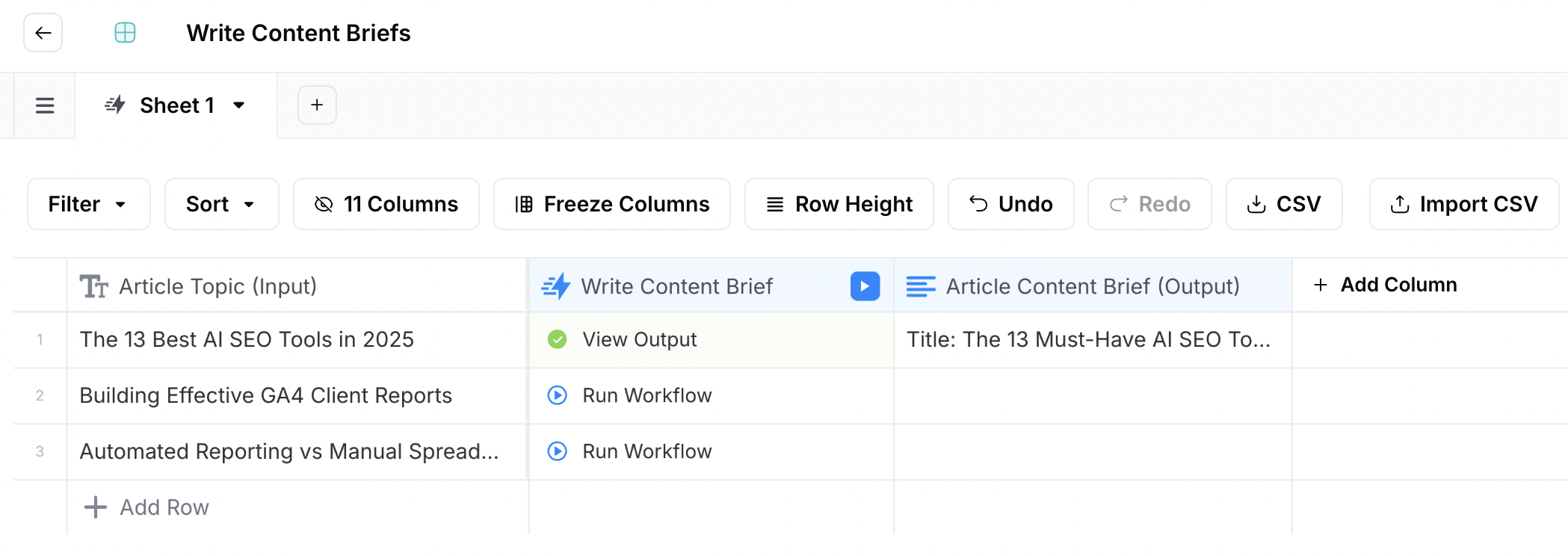
Once you add your topic, the entire research and ideation workflow was done automatically by AirOps. This is what the workflow looks like:
At any point there is an error in one of the steps of the workflow, you can ask their AI Copilot to fix it for you:
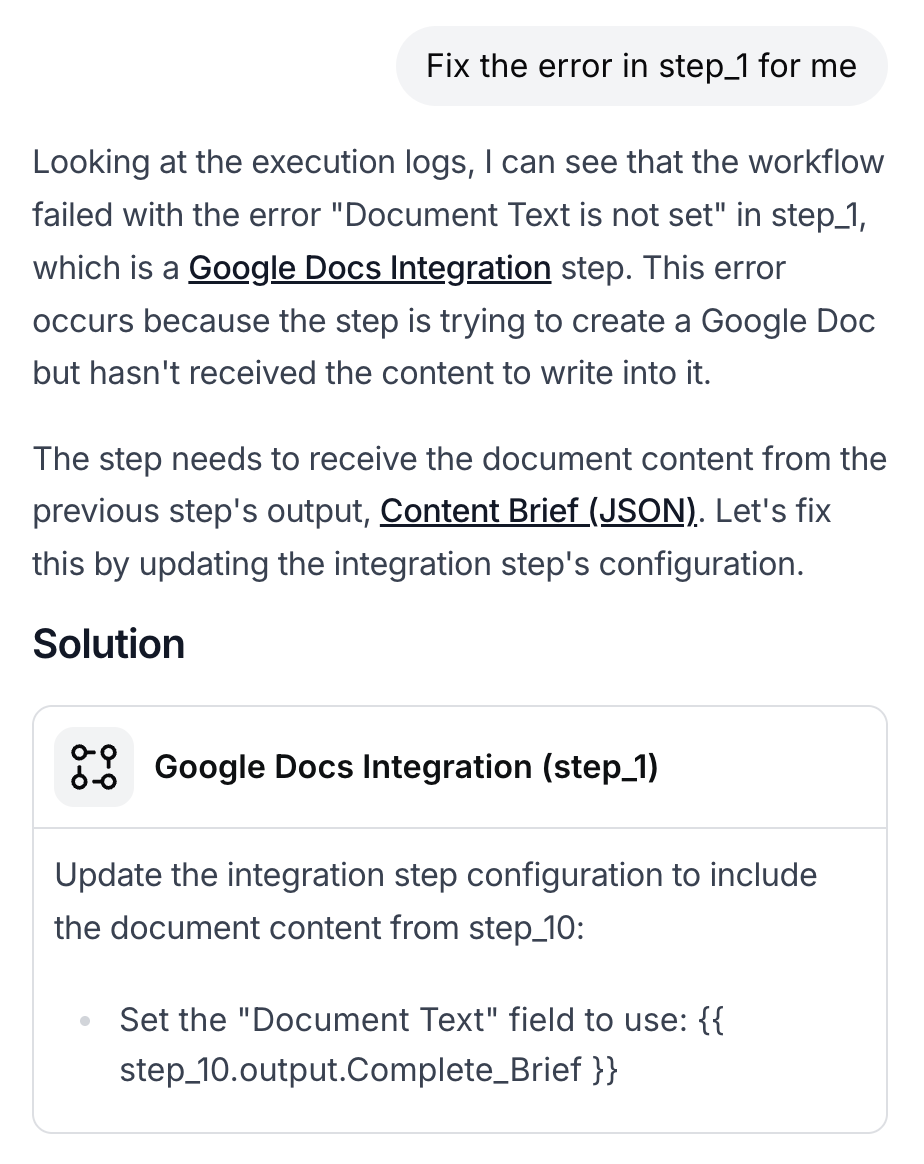 Once the brief is created, it’s automatically added to the original spreadsheet:
Once the brief is created, it’s automatically added to the original spreadsheet:
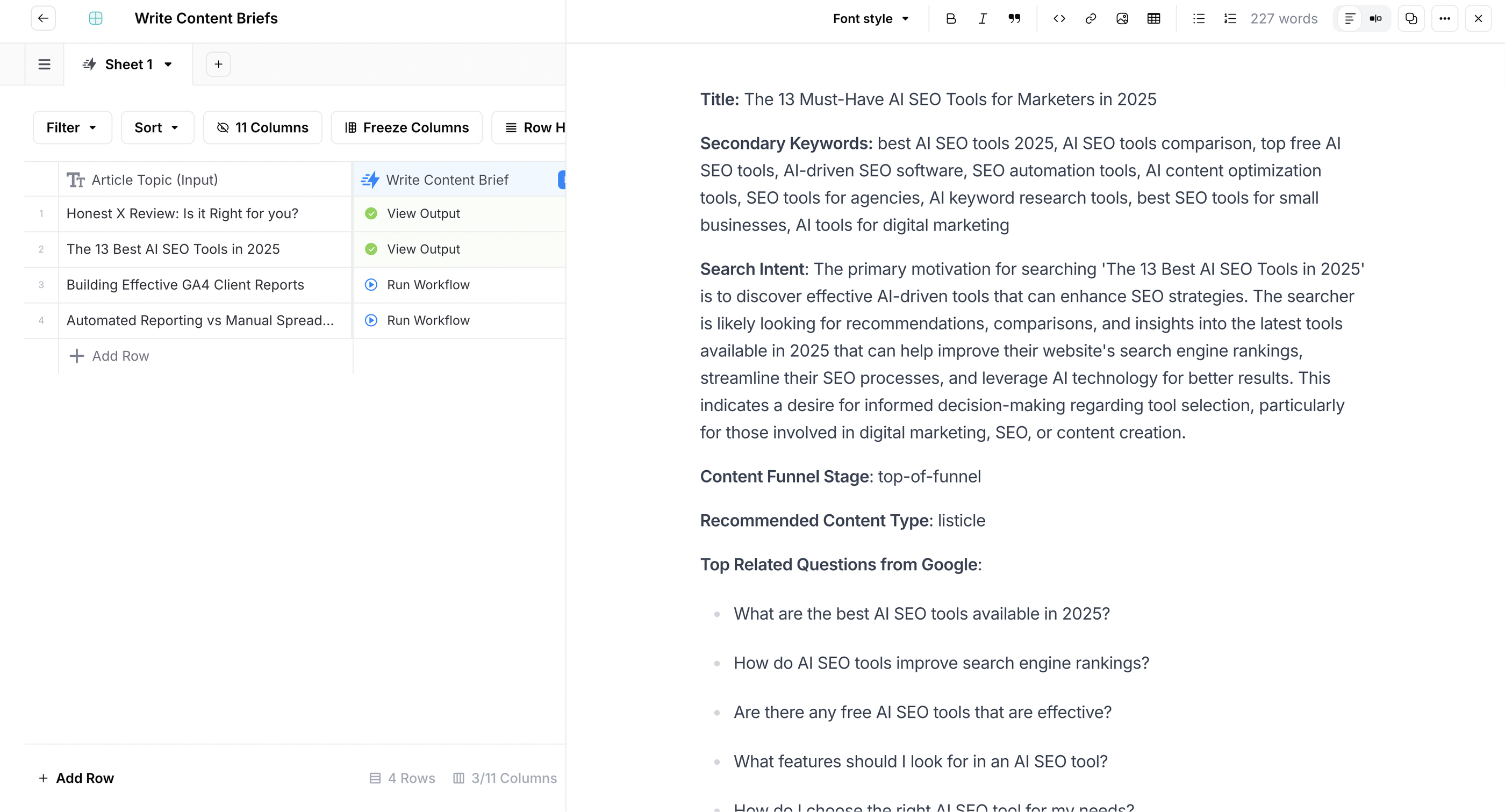 The process was very fast and easy, and I loved how everything is neatly organized in one space.
The process was very fast and easy, and I loved how everything is neatly organized in one space.
The brief itself was very high-level. It does nicely cover the SEO essentials like:
- Secondary keywords
- Search intent
- “People Also Ask” questions from Google
- 3 suggestions for internal links
- Sources
- URL structure
However, it doesn’t dig deep into target audience personas, pain points, and the unique viewpoint of my brand—which is what makes great content.
Next, I asked AirOps to create an article outline based on the brief. This was where it got disappointing.
It created an outline which wasn’t close to what I was looking for. Instead of having specific tools as H2s, it gave categories of tools instead.
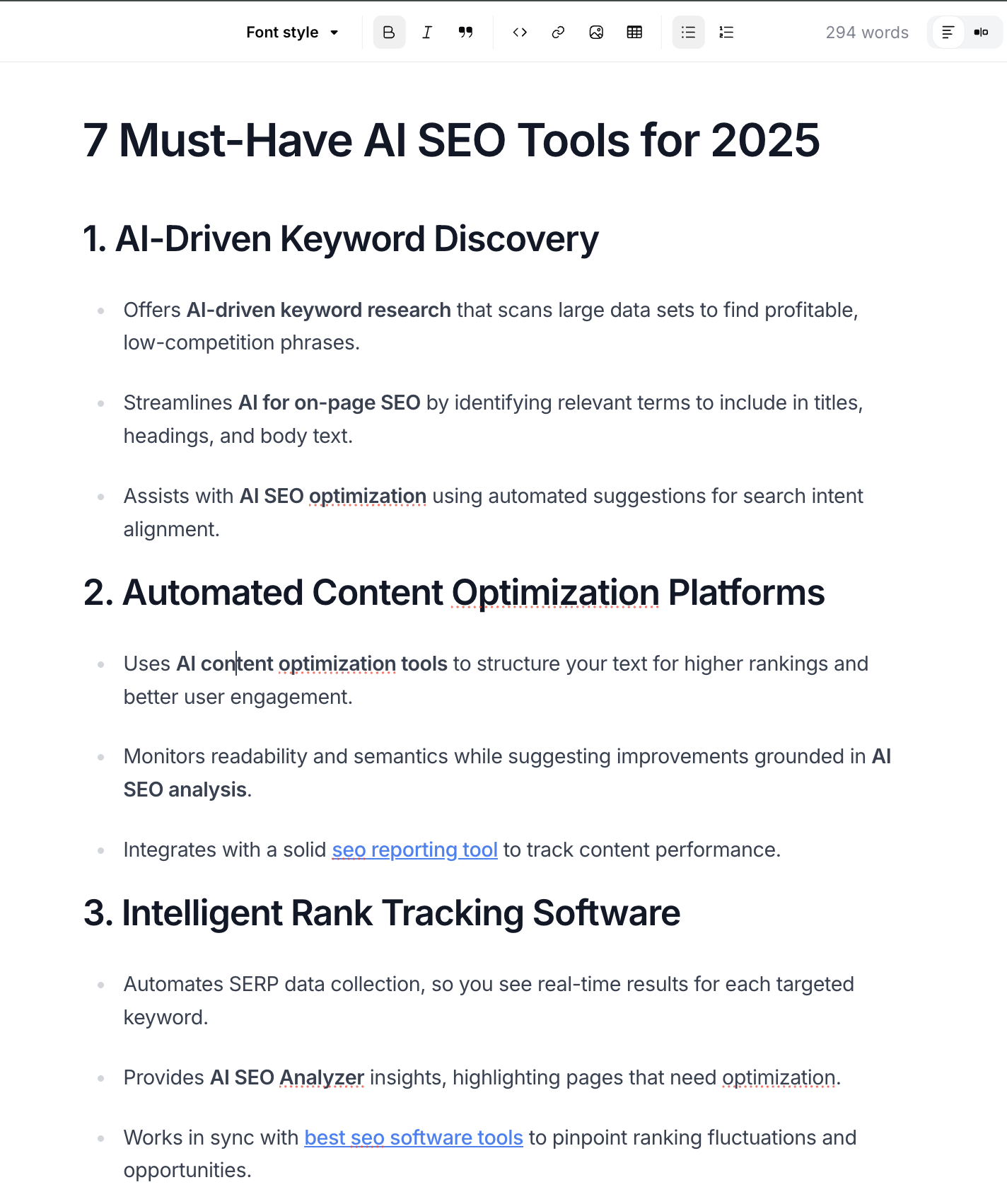 So I created an outline myself, pasted it into AirOps, and asked it to create an article based on the new outline. This was a bummer – I was expecting to be able to do everything on AirOps.
So I created an outline myself, pasted it into AirOps, and asked it to create an article based on the new outline. This was a bummer – I was expecting to be able to do everything on AirOps.
Alright, now the real deal – writing the article itself. To be honest, I was impressed.
Unlike Writesonic, AirOps actually nailed our tone and voice. Check out this introduction:
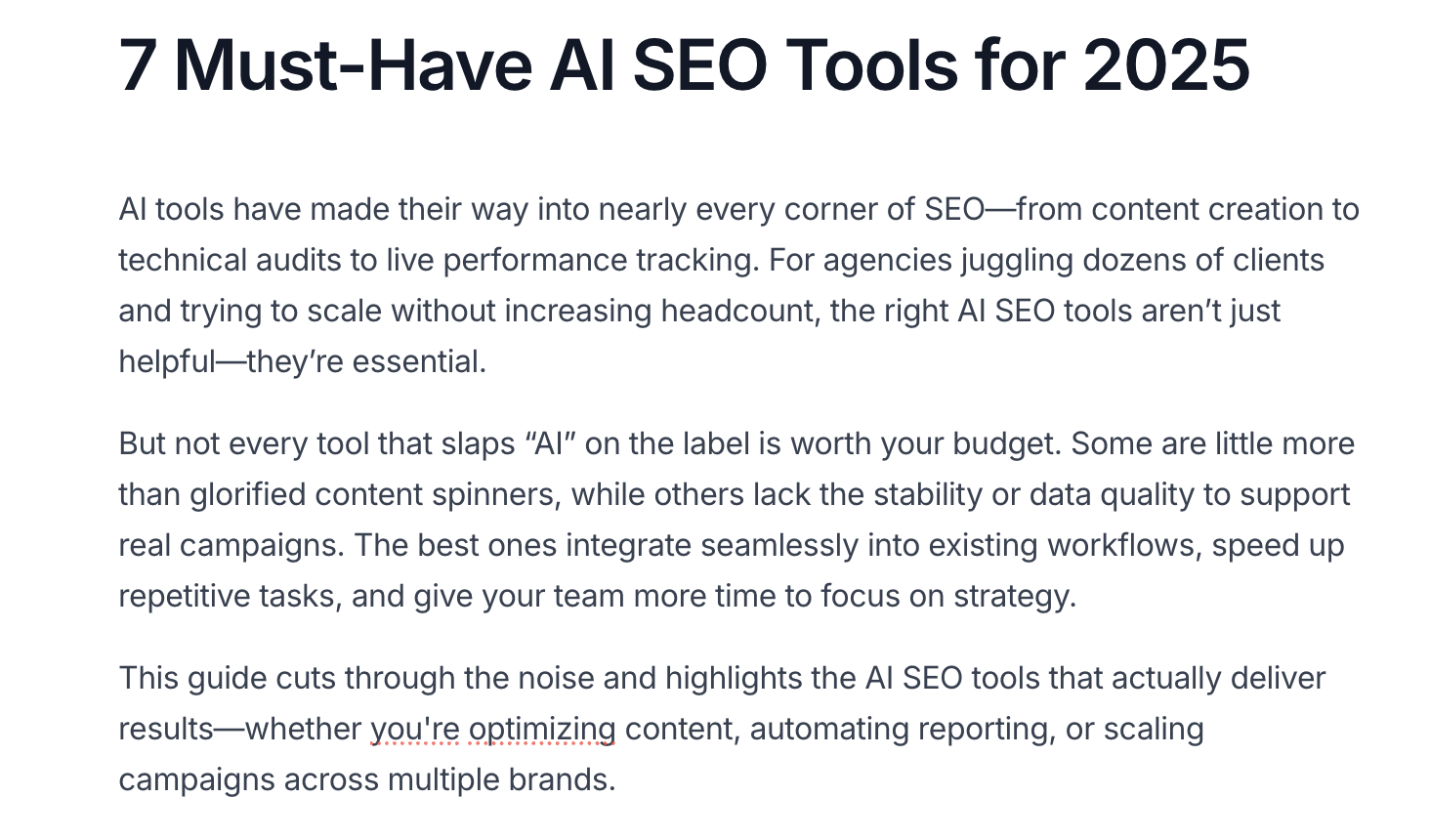
It’s not perfect, but it’s much more on-brand and engaging than what Writesonic produced.
As a last step, you can get AirOps to create a hero image for the article. But as expected, it was meh.
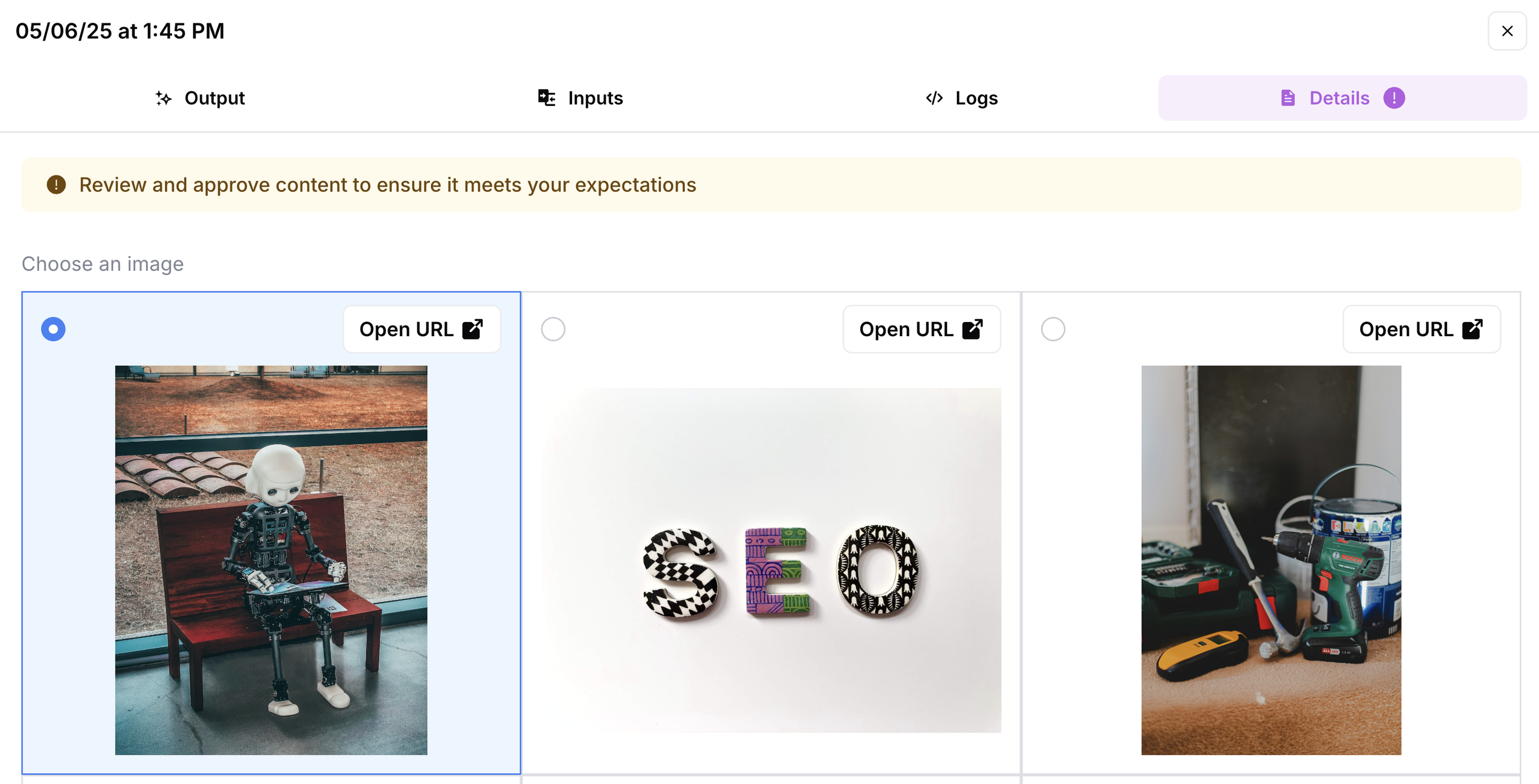
But this wasn’t a deal breaker as we have an amazing in-house graphic designer who creates gorgeous images for us.
Apart from the content creation process, the best thing about AirOps is how well it connects to the rest of your tech stack. You can connect with:
- Google Docs — so you can save briefs and articles right in your drive
- CMS like Webflow, Wordpress, and even Strapi — so you can publish articles straight away
- Slack — so you can share briefs and articles with teammates
- Semrush — so you can do keyword and competitor research
- Google & Perplexity – so you can do real-time, contextual research
And loads more.
In short, AirOps isn’t a plug-and-play writer—it’s more like an SEO command center. And if you want full control over how content is researched, structured, and written (without code), it’s one of the most powerful options out there.
Key features
- Build AI workflows with 40+ models including GPT-4, Claude, and Gemini
- Train models on your brand tone with a customizable Brand Kit
- Create and reuse custom templates for SEO, blog, product, and email content
- Publish directly to CMSs like Webflow, WordPress, Strapi, and Shopify
- Power content with real-time SEO data from Semrush and DataForSEO
- Automate tasks to run on schedules, in bulk, or via triggers
Pricing
AirOps offers simple, scalable pricing designed for content and SEO teams at every stage—from solo operators to multi-brand agencies.
Plan | Price | Best For | Included Highlights |
| Solo | Free | Individuals getting started with AI-powered SEO workflows | 1 user, 1,000 tasks/month, basic templates, 1 brand kit, 5 knowledge sources, 30+ AI models, 10+ CMS integrations |
| Scale | Custom | In-house marketing teams scaling content production | Unlimited users, advanced templates, Semrush integration, scheduled runs, Getty Images, custom CMS support, Enterprise SSO, white-glove onboarding |
| Agency | Custom | Agencies managing content across multiple brands | Everything in Scale, plus multi-account CMS setups, cloned workspaces, and multi-brand billing support |
All plans include access to GPT, Claude, Gemini, and other leading AI models, as well as integrations with tools like Webflow, Shopify, WordPress, and Google Docs.
3. Rankscale.ai
Best for: Tracking your brand’s visibility across AI search engines for specific search terms, regions, modes, and intervals
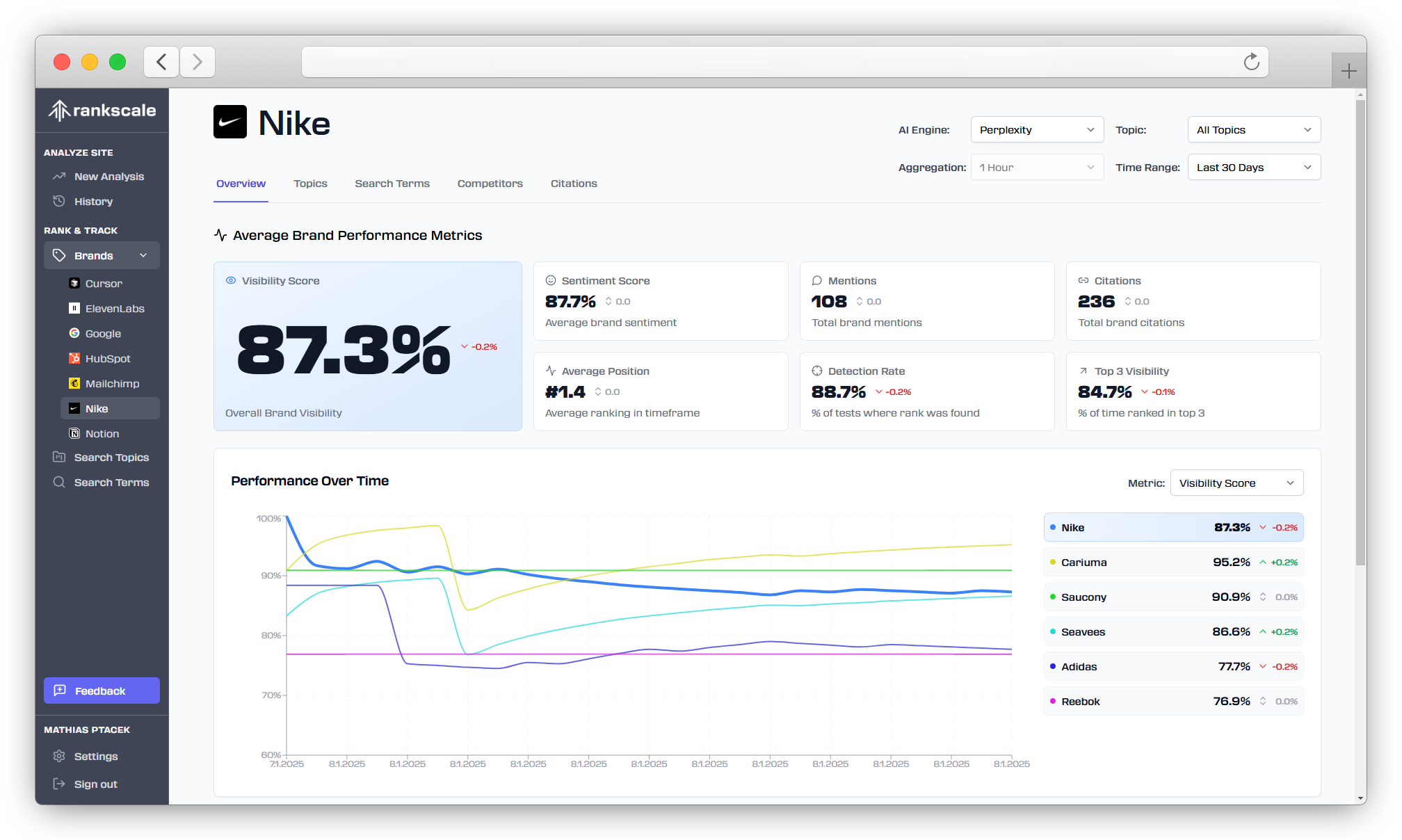
Rankscale.ai is an “Generative Engine Optimization” (or GEO) tool that lets you track whether you’re appearing for specific search terms (and for what position) on AI search engines like:
- ChatGPT
- Perplexity
- Claude
- Google’s AI Overviews
There are tons of GEO tools available in the market right now, but they fall short in two key areas:
- They’re not specific enough — they’ll give you a percentage of how much you’re appearing in AI-generated answers, but not for what terms or which region / country.
- They’re not accurate — AI search is highly subjective based on where you are, how you frame your query, whether you have “live search” turned on, e.t.c., making it difficult to track rankings correctly.
In fact, Brendan Hufford, Founder at Growth Sprints agency, says in this LinkedIn post:
AI search has no universal rankings. The results are hyper-personalized from search to search, making "rankings" fundamentally meaningless.
So, I was a bit skeptical of Rankscale at first. But once I dived into the platform, I learned it solves these two problems quite well. Here's how.
How Rankscale works
Once you log into Rankscale, you’ll land onto the main dashboard where you can find your brand details like:
- Overall AI visibility score
- Search terms you ran trackings for recently
- Credits you have
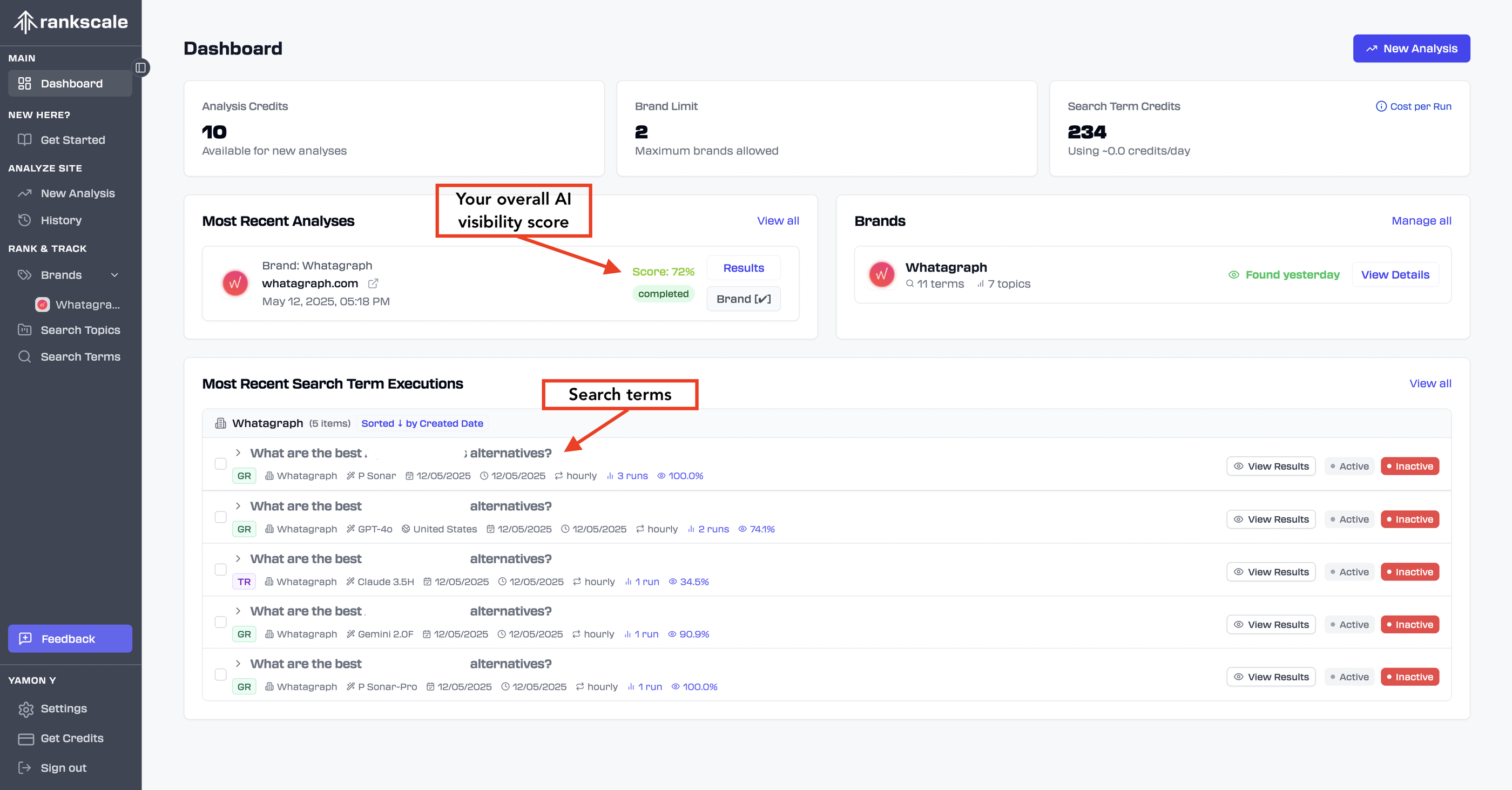
But to get to this point, you first need to run a brand analysis using the top right button. All you need to do is put in your homepage URL and Rankscale will return:
- The “AI search readiness score” which is calculated based on four key areas”:
- Content quality and relevant
- Authority and trustworthiness
- Technical SEO and page structure
- Engagement
- Improvement suggestions for each area
- Recommended search terms (e.g. marketing analytics platforms)
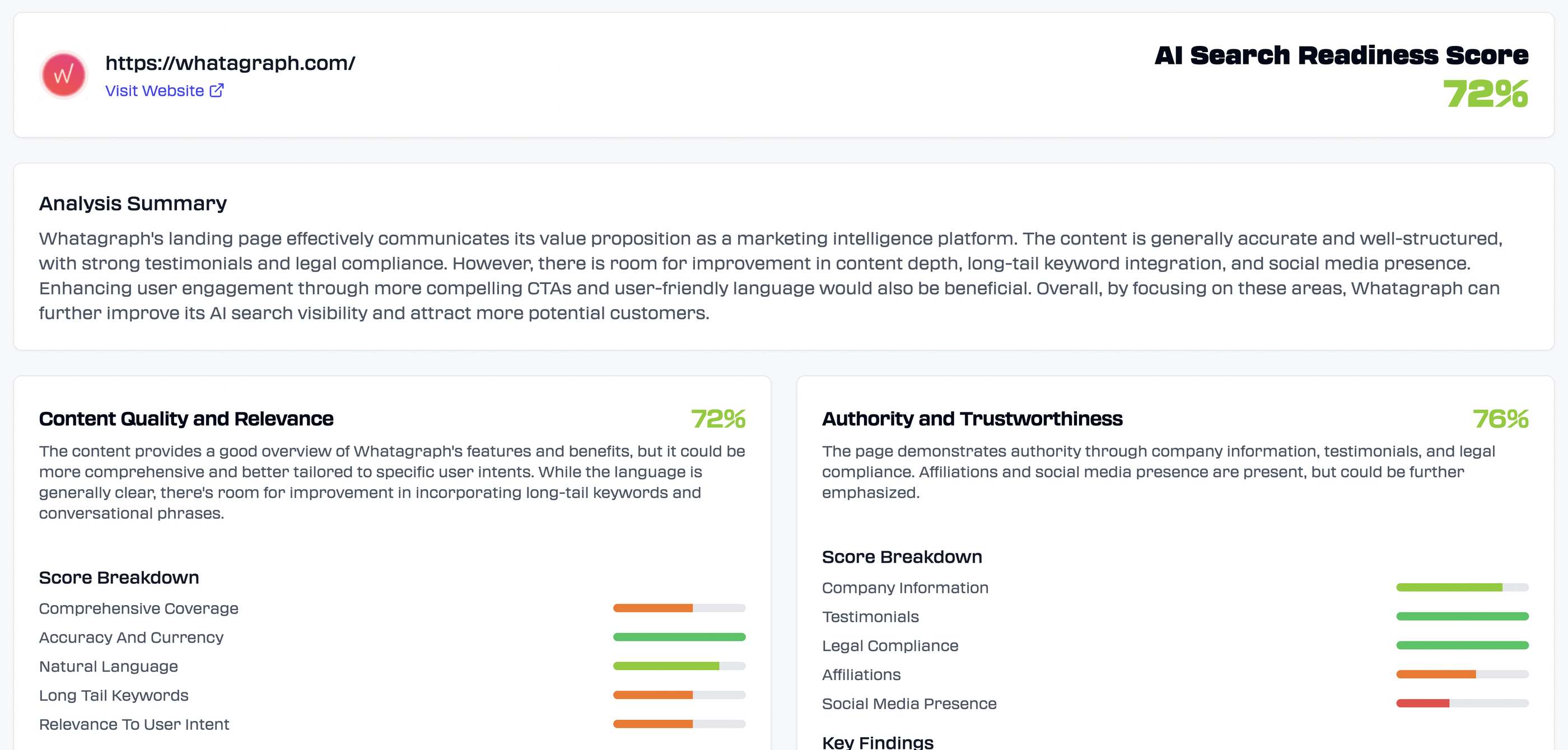
You can then save this as your “brand” and Rankscale gives you another dashboard where you can see:
- Brand performance over time compared to your top competitors
- Topic Performance – which search terms you’re appearing for most
- AI engine performance – which search engines you are appearing on most

Next, you start adding your “Search topics” which can be anything like:
- Content pillars
- Product categories
- Regions
You can either add them manually or ask AI to analyze your website and return search topics for you.
Under each search topic, you can add specific search terms you want to be appearing for in AI answers. Here again, you can ask AI to recommend these search terms for you, or add your own.
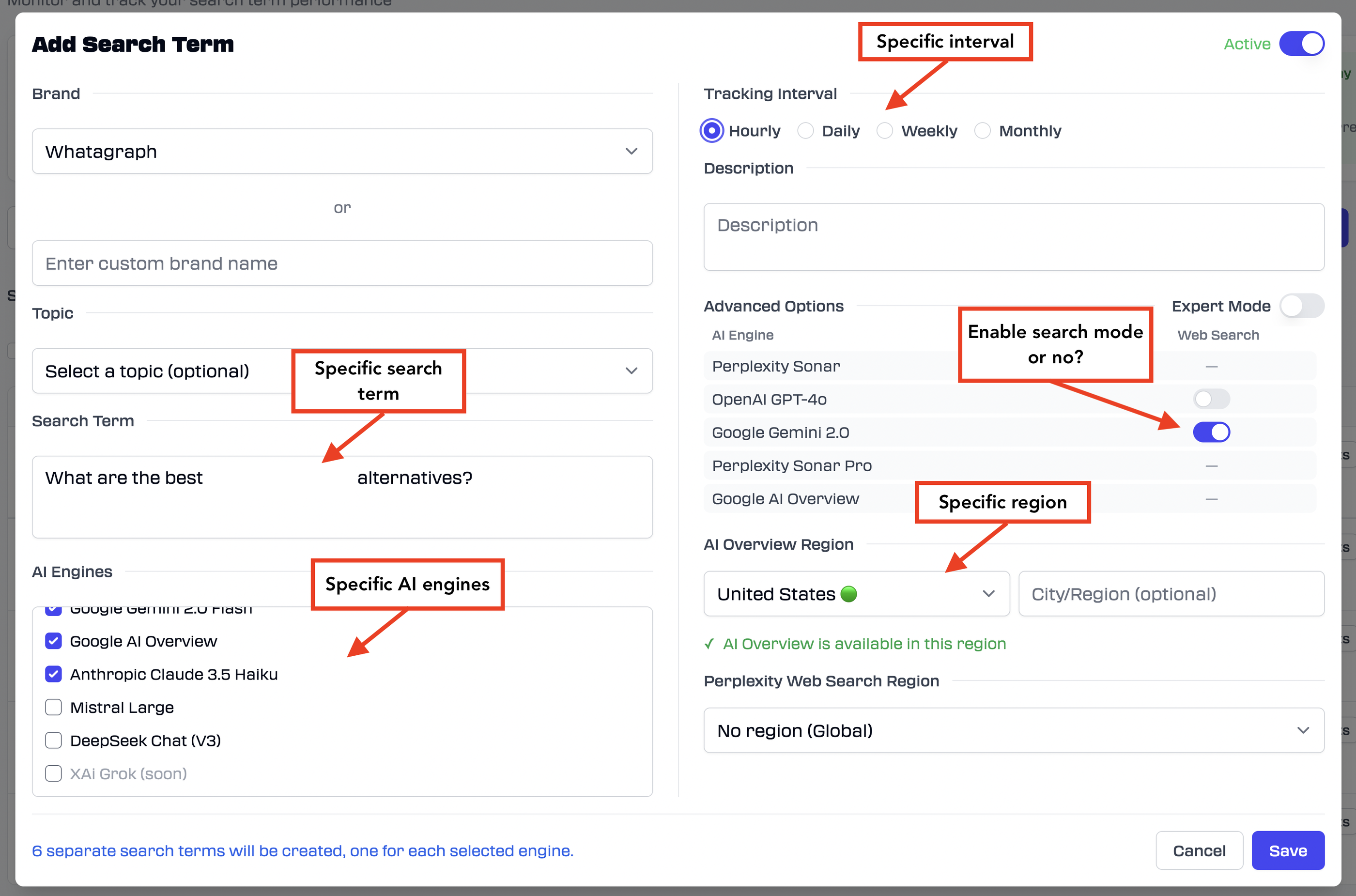
You can see how it’s very specific. You can track specific search terms on specific AI models at specific intervals and for specific regions.
This solves the first problem with AI optimization tools that gloss over details like these.
Rankscale’s founder Mathias Ptacek himself told me:
Rankscale is a bit more like a full drill-down approach for the geeky minds.
If you choose the “Hourly” interval, you’ll get the results in a couple of minutes and the tracking will run every hour. This is good if you want to get results right away but I’d recommend changing to Daily or Weekly so you don’t use up all your credits.
Once you save this, Rankscale will create separate search terms depending on how many AI engines and regions you chose.
You can go into each of these search terms from your main dashboard and it’ll open up a full “results” page with an overview like so:

This specific search term is a BOFU one – “What are the best [competitor] alternatives?” – on Perplexity.
And the best thing was that I could see where Whatagraph is ranking vs. our competitors for this specific term, plus what’s the sentiment behind each brand:
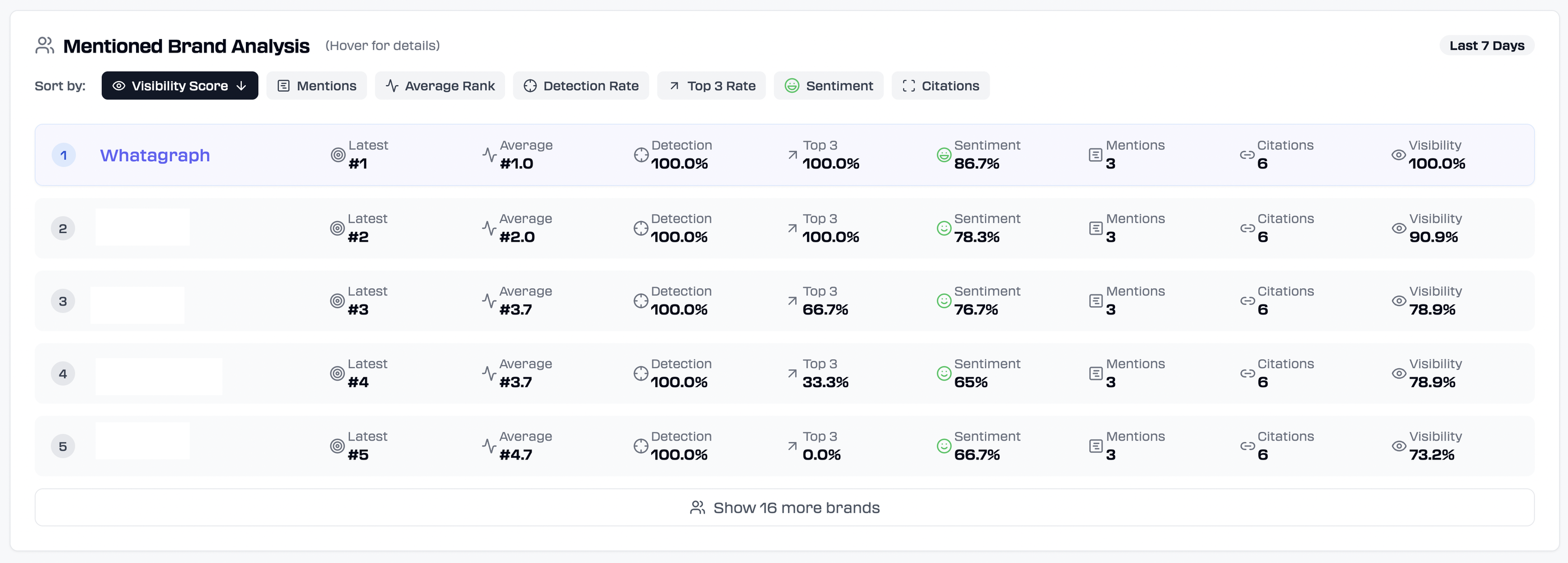 It’ll also show you the articles it cited and pulled their answers from, and ours was first:
It’ll also show you the articles it cited and pulled their answers from, and ours was first:
 Is Rankscale accurate?
Is Rankscale accurate?
Now this is where it gets juicy.
At first, it wasn’t.
Rankscale said we were ranking number #8 on ChatGPT for the same BOFU query — “What are the the best [competitor] alternatives?”. But when I cross-checked with GPT-4o, we were actually #1.
So I reached out to Mathias, Rankscale’s founder, and it turns out it was because I hadn’t enabled the “Web search” function on Rankscale.
Once I enabled it and re-ran the tracking, it accurately showed me we were ranking #1: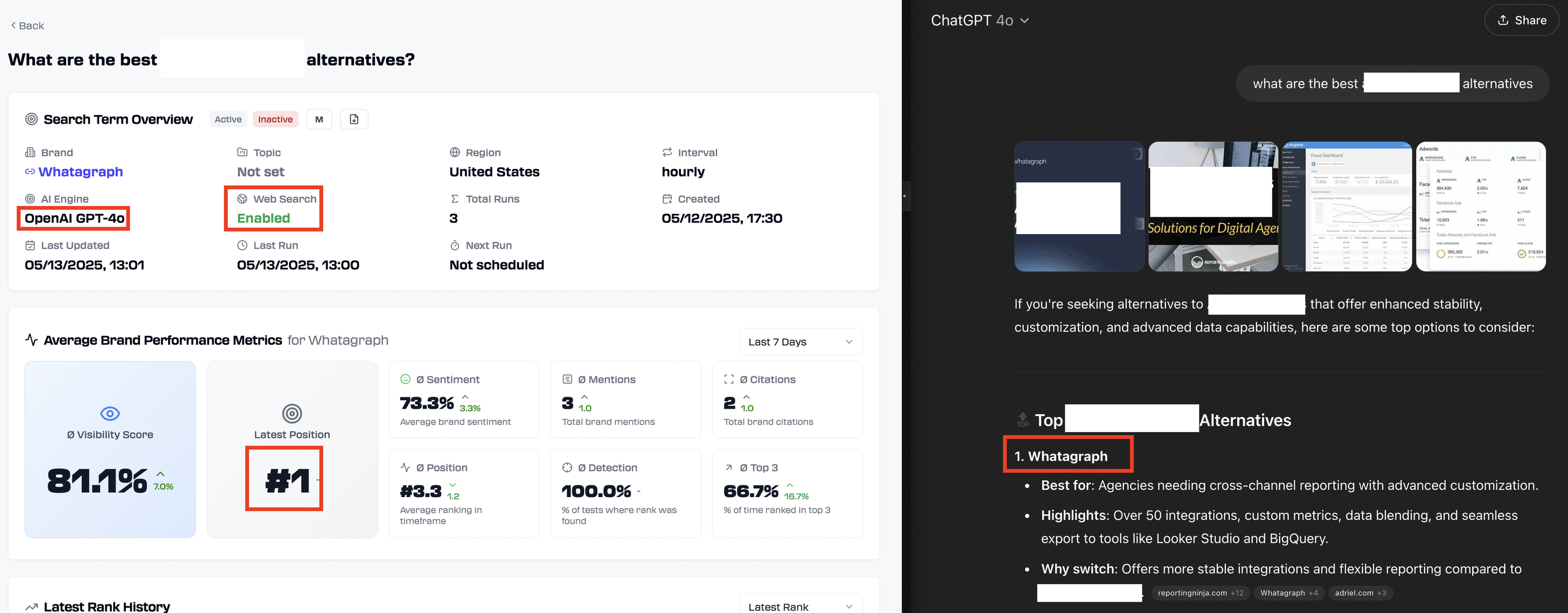
Another important thing for us are the Google AI overviews. Rankscale shows that we are ranking #3 for the same BOFU query, and we are indeed number #3. But in the screenshot below, you can see the rankings for other tools are not as accurate.

So, Rankscale seems to be accurate in general, but AI Overviews and LLM answers fluctuate wildly. Even if you change a word or a punctuation slighly, the answers and rankings can be different.
But the level of specificity Rankscale offers is unmatched. If you want to track GEO for specific terms, specific AI platforms, and specific regions, this is the tool for you.
(Side note: We ended up choosing it for our internal GEO monitoring.)
Key features
- Track visibility across ChatGPT, Perplexity, Claude, and Google AI
- Monitor rankings for specific keywords by engine and region
- Analyze sentiment in AI-generated mentions of your brand
- See which sources AI tools cite when referencing your content
- Benchmark visibility against top competitors
- Get content recommendations to boost AI search performance
- Integrate with tools like SEMrush and Surfer SEO
Pricing
Rankscale operates on a pay-as-you-go, credit-based model, which makes it super flexible for agencies. You don’t have to buy a monthly subscription or pay upfront for a year contract. You just top-up your credits as you go.
Plans start from $20 (one-time payment) and include credits for tracking specific keywords across multiple AI search engines and locations.
As of May 2025, Rankscale is open for exclusive early-access and you can get a set amount of credits for free.
4. SE Ranking AI Overview Tracker
Best for: Tracking AI overviews granularly
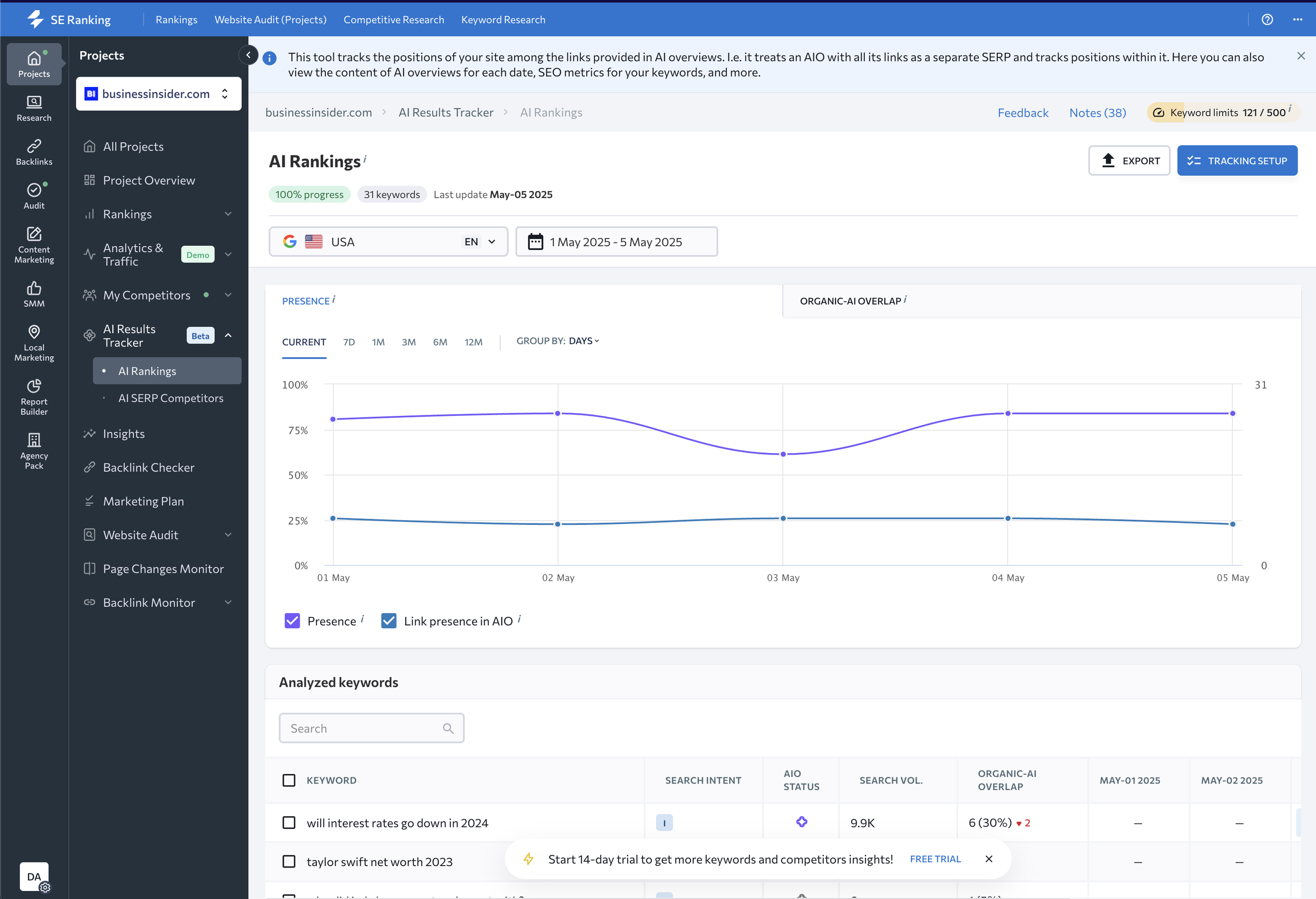
SE Ranking is a comprehensive AI-powered platform and one of the leading SEO ranking tools that provides keyword tracking, site audits, competitive research, and AI-specific insights.
But for the sake of this article, I’ll focus on its key AI feature — AI overviews tracker.
SE Ranking’s AI Overviews Tracker helps you monitor where—and how—you’re showing up in Google’s AI-generated answers.
It helps you answer questions like:
- Are we showing up in AI Overviews for our target keywords?
- How does our organic ranking compare to AI-generated results?
- What competitors are being surfaced by Google’s AI?
The AI Overview Tracker tells you which keywords trigger AI Overviews, whether your site is listed as a source, and how your performance stacks up against competitors.
You can also see historical SERP versions, model potential AI-driven traffic, and understand the intent behind queries that surface AI results.
The difference between Rankscale and SE Ranking is that the latter is a comprehensive SEO optimization and monitoring platform (similar to Ahrefs and Semrush) that comes with an AI Overview tracker, while Rankscale is purely an GEO tracking tool.
How SE Ranking’s AI Overview Tracker works
1. Select your project
Open SE Ranking’s AI Results Tracker and choose the project you want to analyze.
2. Pick your keywords
Add the keywords you want to monitor and select the search engines to track.
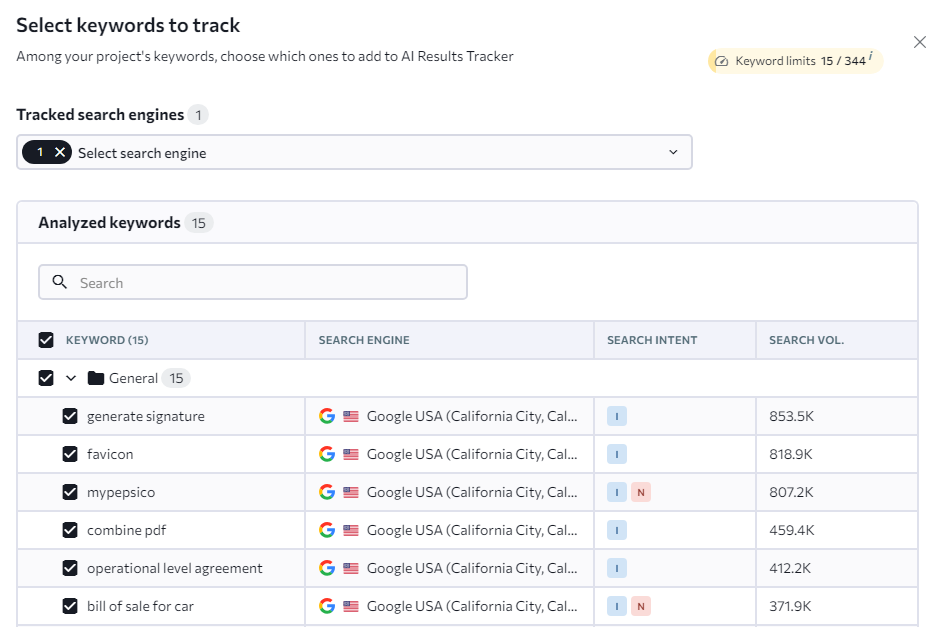
3. Check AI Overview presence
See how many of your keywords trigger AI Overviews and whether your site is featured.

4. Analyze Organic-AI Overlap
Check the share and total number of URLs from the organic Top 20 that are present in the AI overview. The chart below shows the average values across keywords for which an AI overview is present.
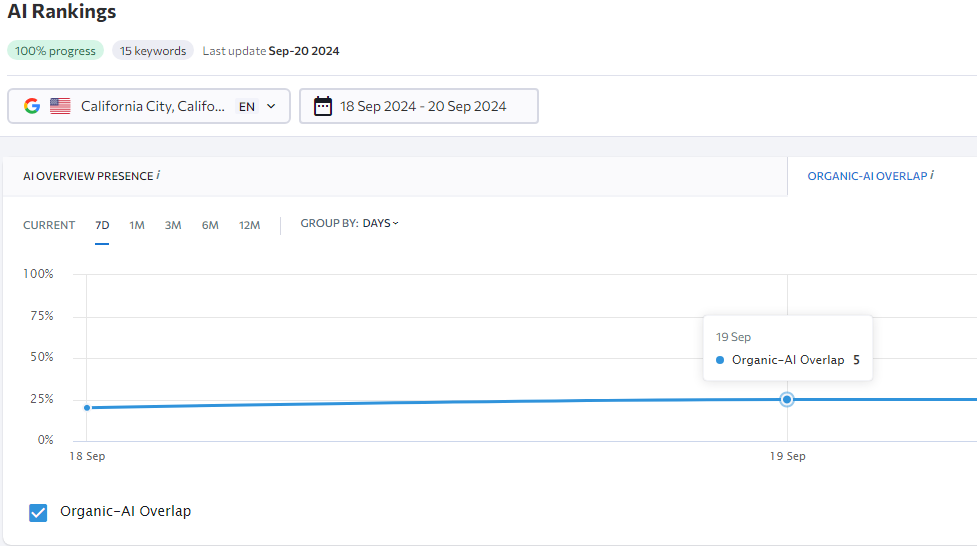
In the screenshot above, the Organic-AI Overlap is 5, meaning that five links, on average, appear in both organic search results and AI Overviews.
5. Monitor your rankings
Track changes in AI rankings over time and compare them to your organic search performance.
See the AI Overview status for each keyword, search intent, search volume, and Organic-AI overlap.
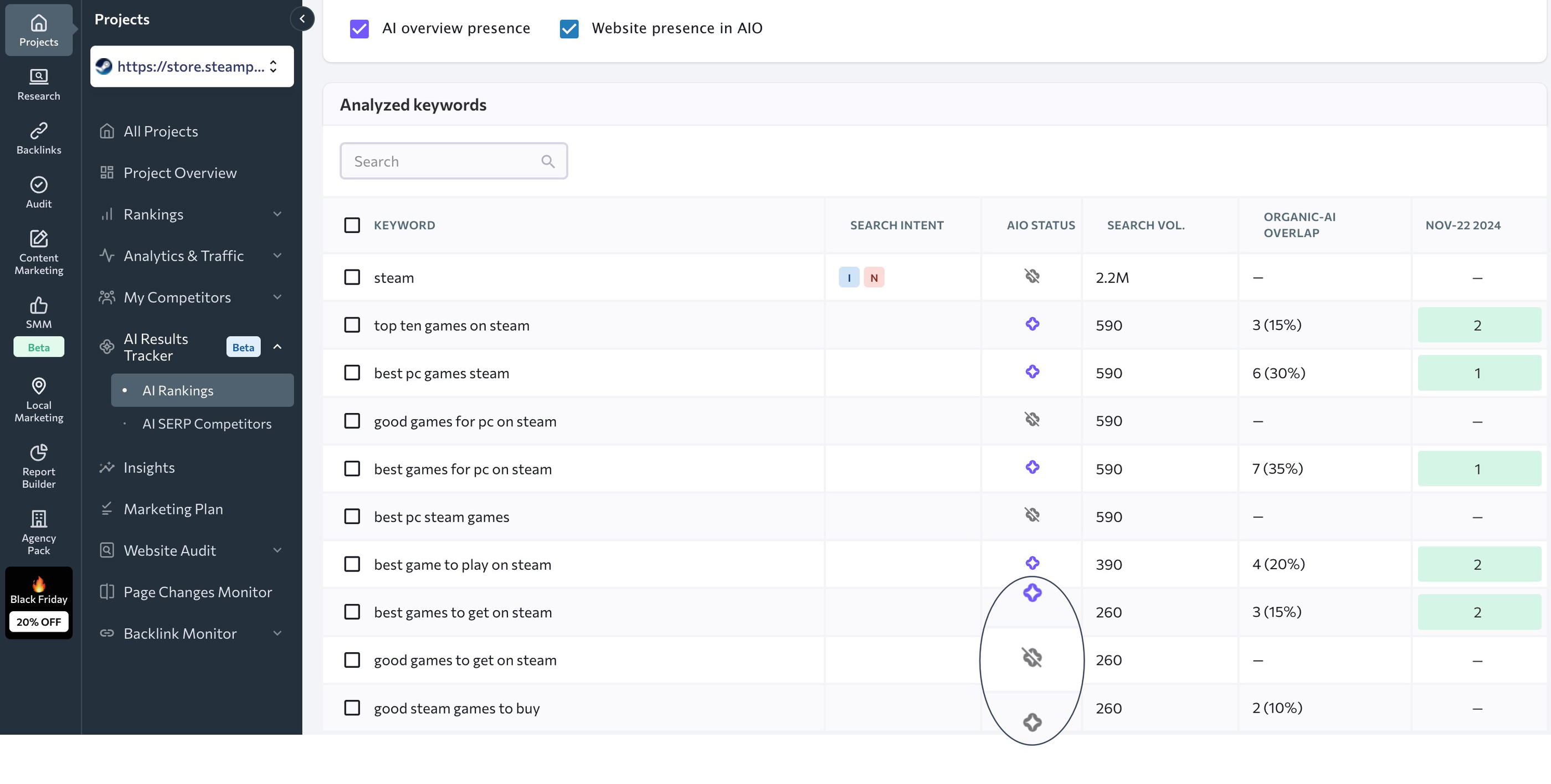
6. Keep an eye on competitors
Use the AI SERP Competitors feature to see which sites are ranking in AI Overviews for your target keywords.
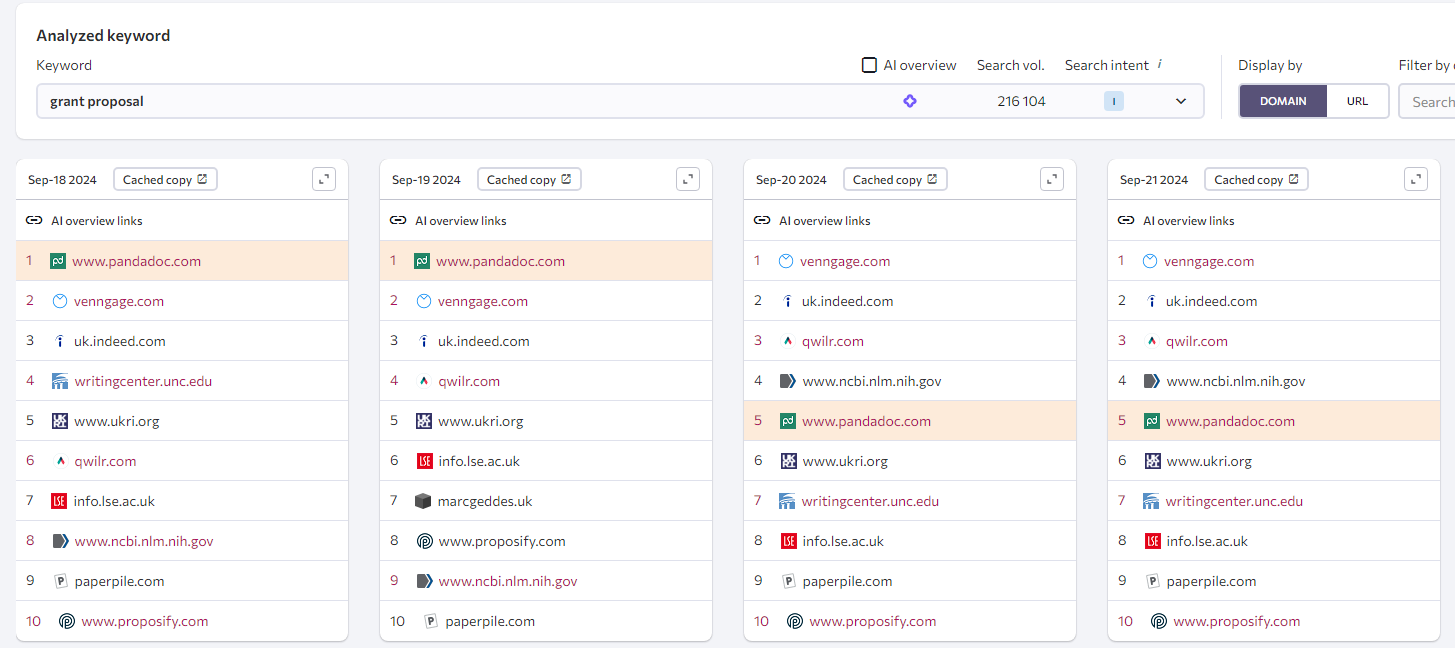
You can see a product tour of this feature here.
Key features
- Track which keywords trigger AI Overviews and if your site is cited
- Compare rankings in traditional SERPs vs. AI-generated results
- See which competitors appear in AI Overviews and why
- View historical SERP snapshots to track AI snippet changes
- Analyze keyword intent and volume for AI-triggering terms
- Estimate traffic from AI placements with modeled projections
- Access full SEO toolkit with rank tracking, audits, and backlinks
Pricing
Here’s the SE Ranking pricing as of May 2025:
Plan | Price (Annual) | Keywords to Track | Manager Seats | Projects | AI Tracker Access |
| Pro | $95.20/mo | 2,000 | 3 | 30 | Yes |
| Business | $207.20/mo | 5,000 | 5 | Unlimited | Yes |
Add-ons available:
- Agency Pack: $50/mo → White-label reports, client seats, and agency directory listing
- Content Marketing Tool: $29/mo → AI writer, content editor, plagiarism checker
- Local Marketing Tool: $9/mo → Google Business Profile, citation monitoring, local rank tracking
Prices above reflect annual billing with savings applied. Monthly billing available at higher rates.
5. Clearscope
Best for: Optimizing human-written content for SEO so it ranks fast and well
I’ve been using Clearscope religiously for 3 years.
It's one of my favorite SEO optimization tools—not because it writes me an entire article with AI, but because it gives clear, data-backed suggestions to help my human-written content rank better.
Clearscope is essentially a content optimization platform that:
- analyzes the top-ranking pages for your target keyword
- tells you what keywords you should include in your article and which topics to frame it around
…so you can rank your article faster.
There are three core tools in Clearscope:
- Content report
- Content inventory
- Topic research
For this article, I’ll focus on Content Report, which I use almost daily.
Over the past 3 years I’ve been using it, I’ve found that articles optimized with Clearscope rank faster and higher than articles that aren’t.
It’s intuitive, smart, and non-invasive —it doesn’t try to write the article for you or force you to over-optimize your content.
Here’s what you get inside a Content Report:
- A list of related keywords and entities to include naturally in your draft
- A target word count range (pro tip: aim for at least 80–150% of that number)
- Readability score guidance
- “People Also Ask” questions for structuring subtopics or FAQs
- Live scoring as you write, either in Clearscope or in Google Docs
How Clearscope’s Content Report works
- Run a report: Enter your keyword and generate a content report based on what’s ranking in the top results.
- See what to include: Clearscope surfaces key terms, questions, and competitor content insights—no guesswork needed.
- Write directly in Clearscope (or sync with Google Docs): Get live feedback as you write. Score your content based on keyword coverage, readability, and structure.
- Collaborate across teams: Assign tasks, track progress, and use real-time commenting for a smoother workflow.
What I really appreciate is how smart and forgiving it is. You don’t need to use exact-match keywords to get credit. Clearscope recognizes semantic variations and context—something other AI tools for website SEO like Surfer SEO don’t always handle well.
I also love that they have a Chrome extension that you can add directly to your Google Docs as you’re writing, and it highlights the keywords you’ve added. Here’s an example as I was writing this section:
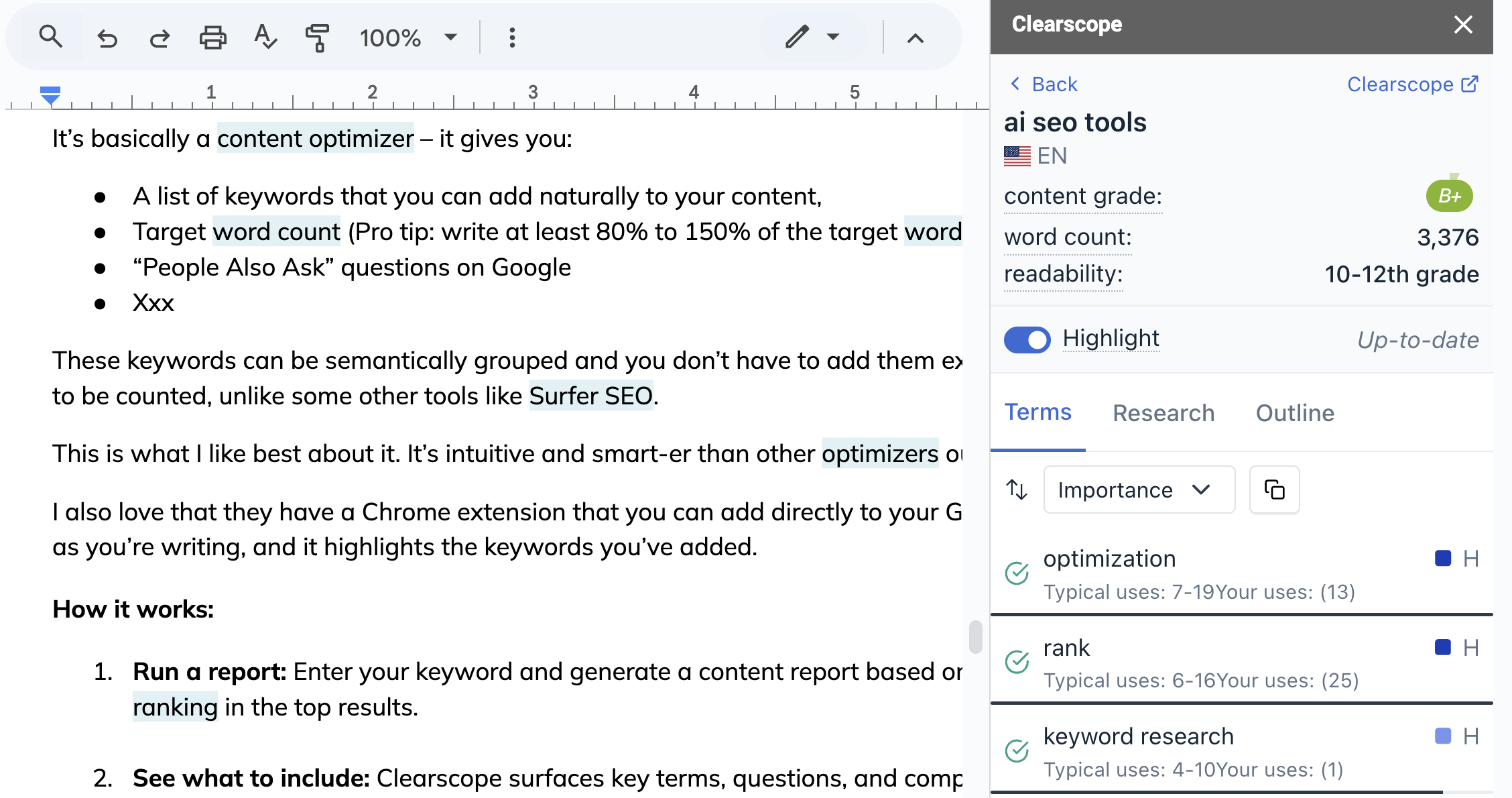 This means I don’t have to waste time copying and pasting my content into Clearscope, optimizing with keywords, and then copying back into Google Docs. It’s all done intuitively in Google Docs, which I use as my single source of truth.
This means I don’t have to waste time copying and pasting my content into Clearscope, optimizing with keywords, and then copying back into Google Docs. It’s all done intuitively in Google Docs, which I use as my single source of truth.
For someone with an attention-deficit brain, this is gold. It keeps me focused and organized, and lets me work where I’m already writing.
Within Content Report, there’s also the AI Outline feature which generates a content outline based on your primary keyword and competitor articles currently ranking in the SERP.
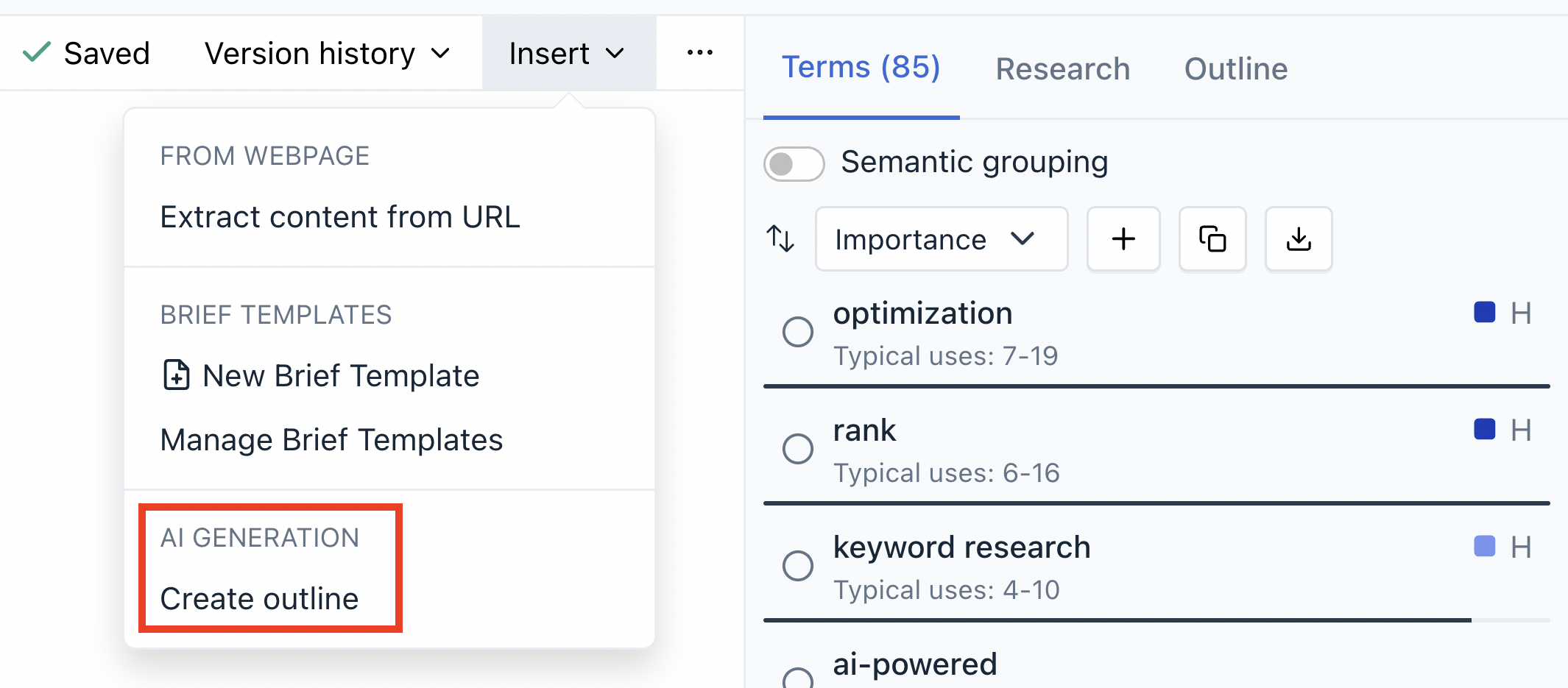 Honestly, I haven’t used this feature before but I tried it out for our article “AI SEO tools” and this was the outline it gave me:
Honestly, I haven’t used this feature before but I tried it out for our article “AI SEO tools” and this was the outline it gave me:
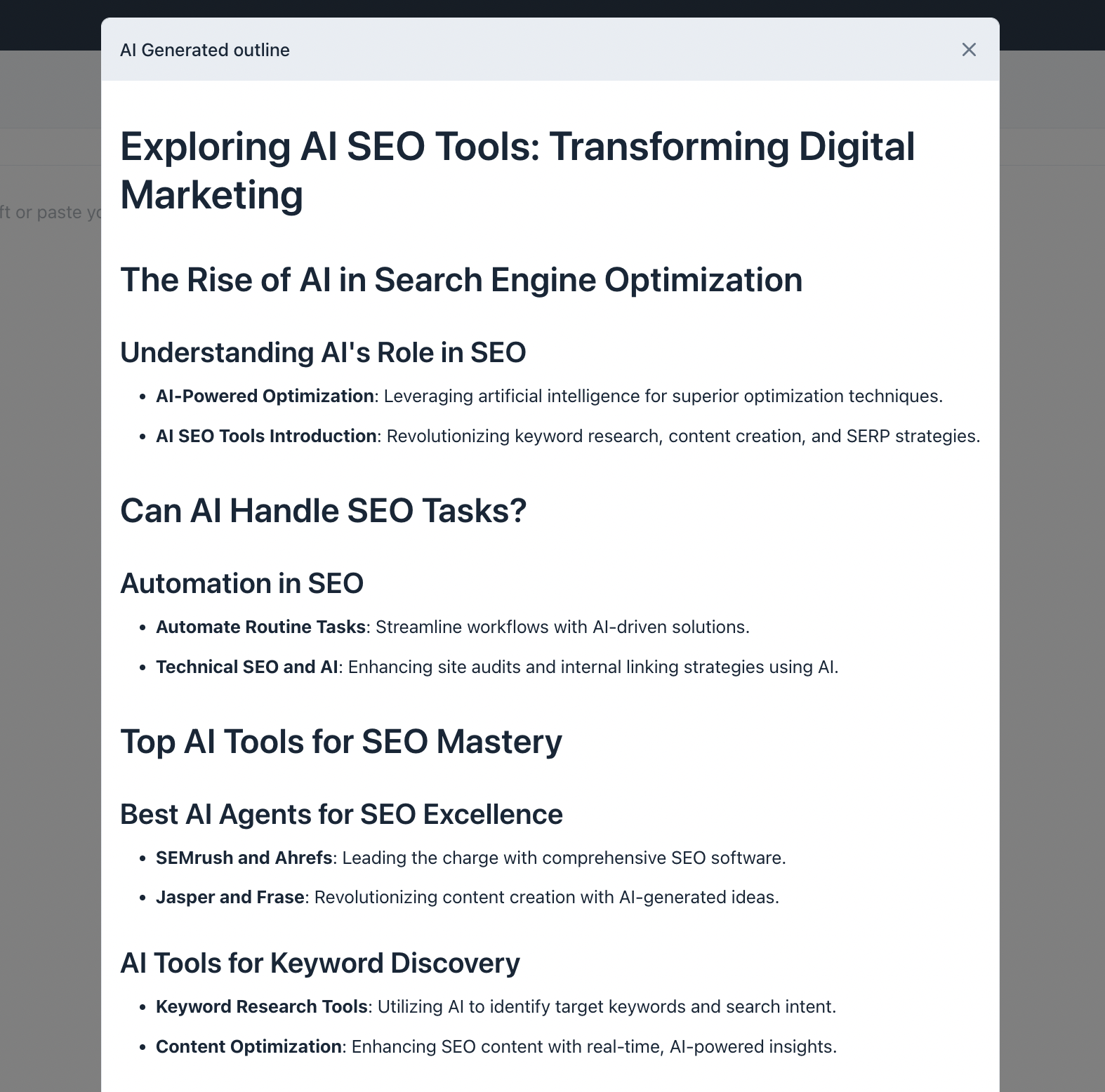 Unfortunately, this didn’t live up to my expectations. The outline had a lot of “fluff” content like “Understanding AI’s Role in SEO” that sounds very…AI…and doesn’t meet the search intent for the term. Like AirOps, it also grouped tools by category, which wasn’t what I was looking for.
Unfortunately, this didn’t live up to my expectations. The outline had a lot of “fluff” content like “Understanding AI’s Role in SEO” that sounds very…AI…and doesn’t meet the search intent for the term. Like AirOps, it also grouped tools by category, which wasn’t what I was looking for.
Key features
- Keyword and readability suggestions from top SERPs
- Live content scoring as you write
- Search intent matching with topic suggestions
- Google Docs integration with real-time sidebar
- Team collaboration with comments and assignments
- Multi-language optimization support including English, Spanish, German, and more.
Pricing
Clearscope offers simple, no-contract pricing built for teams that take content quality seriously. Here’s the pricing as of May 2025:
Plan | Price (Monthly) | Included Features |
| Essentials | $189/month | 100 Content Inventory Pages, 50 Keyword Discoveries, 20 Content Reports |
| Business | $399/month | 300 Inventory Pages, 50 Keyword Discoveries, 20 Reports, Dedicated Account Manager |
| Enterprise | Custom pricing | Everything in Business plus custom usage, SSO, crawler whitelisting, and more |
Add-ons:
- +100 Content Inventory Pages: $25/month (Essentials) or $15/month (Business)
- +10 Content Reports: $100/month (Essentials) or $30/month (Business)
- Enterprise add-ons: Custom pricing
Always included:
- Free training and onboarding
- Priority support for all customers
- Unlimited sharing and exporting
- Flexible plan upgrades—no contracts, no friction
Clearscope is indeed a bit more expensive, but you’re paying for quality and all the “perks” like free training and onboarding and great customer support.
6. Ahrefs AI Content Helper
Best for: Ahrefs users who want to optimize content around real search intent, without over-optimizing or writing for bots
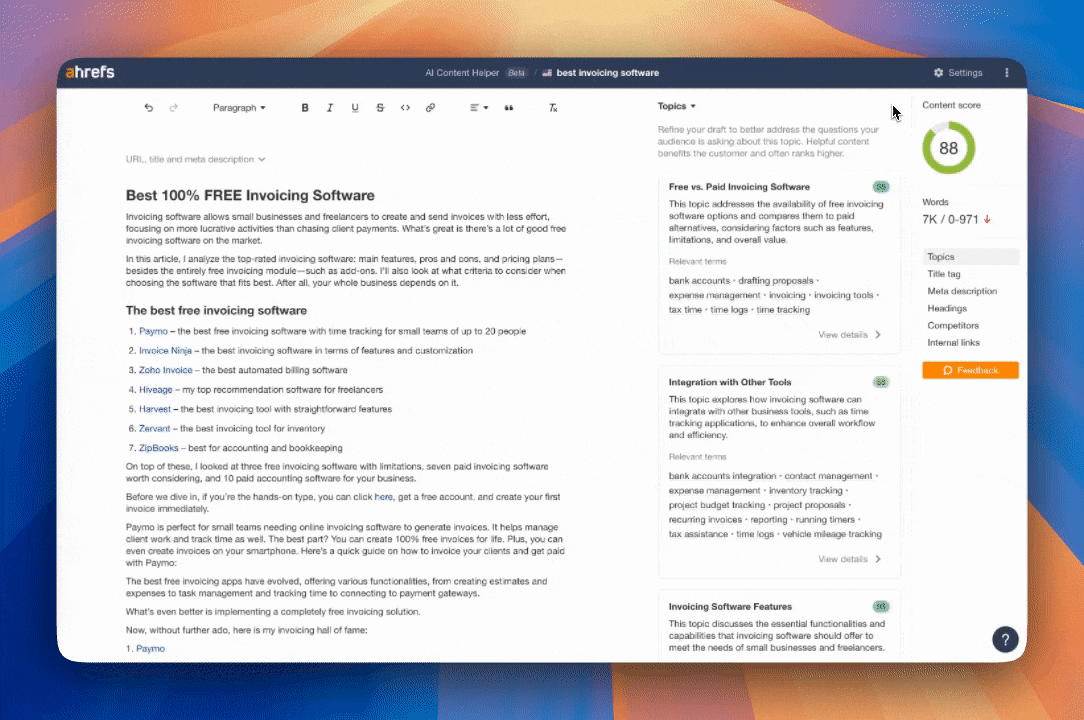
If you’re already paying for Ahrefs and you don’t want to pay for a separate content optimization tool like Clearscope? You’re in luck.
Ahrefs’ newly released feature (released September 2024), AI Content Helper, helps you write content that aligns with real search intent and meets Google’s standards—without over-optimizing or sounding like AI wrote it.
Instead of pushing keyword density, it focuses on comprehensive topical coverage, competitor-backed insights, and smart AI assistance.
Essentially, it’s like an editorial sidekick that helps you write content both people and search engines will trust.
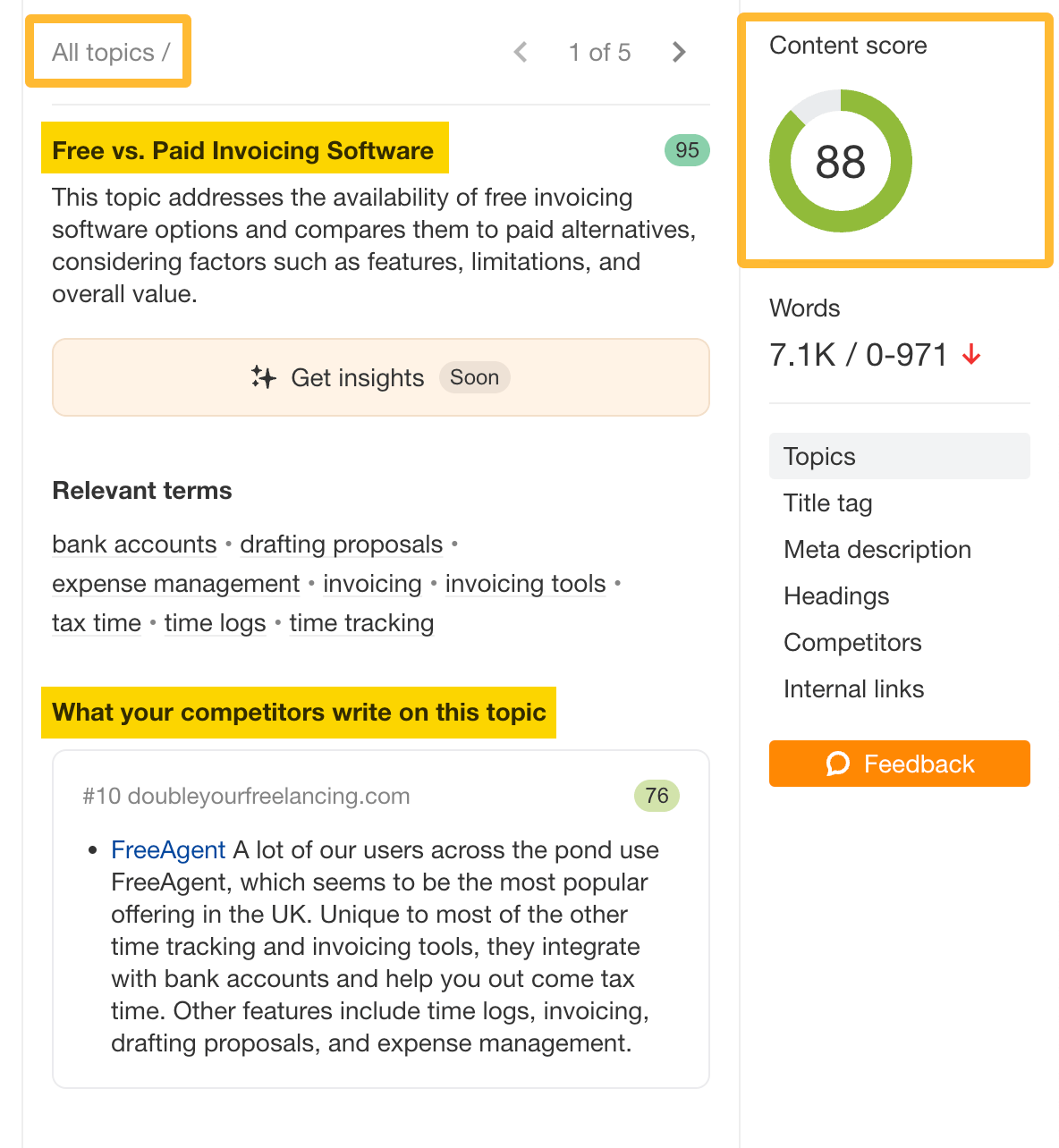
How it works
- Enter your target keyword to kick off the optimization process
- Choose a search intent from the top-ranking SERPs (or let Ahrefs group by intent for you)
- Get real-time topic coverage scores based on top-ranking competitors
- Review gaps by studying how your competitors cover missed or weak topics
- Use AI to improve—rephrase, summarize, expand, or generate metadata
- Structure your content based on how top-ranking articles are built
It’s currently in free beta for all Ahrefs paid users.
As trivial as it sounds, the best thing I like about Ahrefs AI Content Helper is the meta title and description generator.
I love writing the actual content, but always find it annoying to do little SEO tweaks like that, and with Ahrefs, you can ask AI to write it out for you. You can also see what other competitors have written as their meta descriptions.

Another cool thing I love about Ahrefs AI Content Helper is their “AI chat”. Once you have written or copied and pasted in content, you can ask AI for feedback on the content.
Get it to pick holes in your content, to see if it’s SEO-optimized enough, or if you’re sounding like a robot….whatever floats your boat. This is super useful for one-person content teams or introverted writers who want to improve their craft.
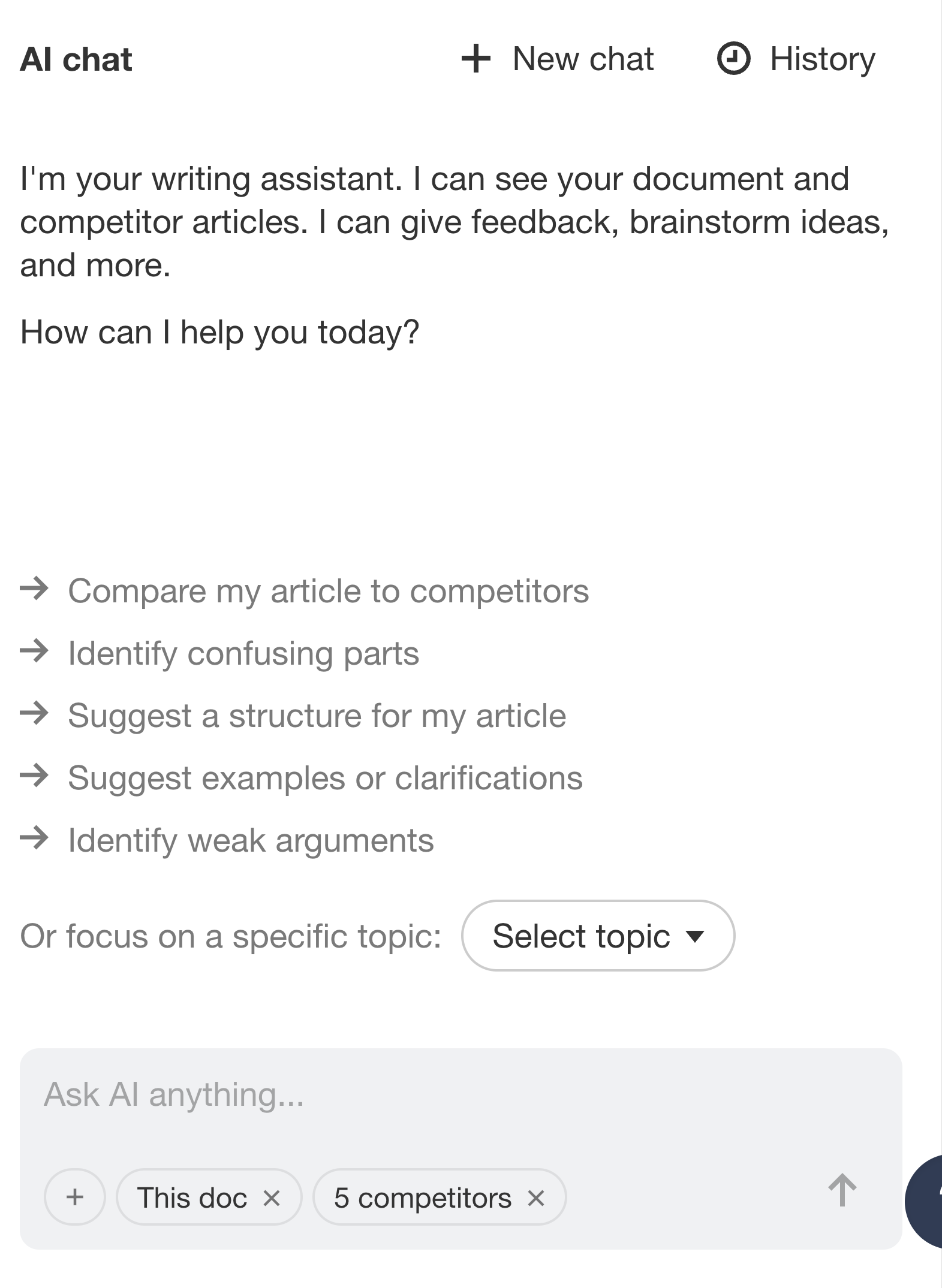
Key features
- Group keywords by search intent automatically
- Score content based on topical coverage, not keyword count
- Get competitor-backed suggestions for content gaps
- Rephrase or expand content with an AI writing assistant
- Generate SEO titles and meta descriptions instantly
- Analyze heading structures from top-performing pages
Pricing
Ahrefs’ AI Content Helper is bundled into Ahrefs’ broader SEO platform. Pricing depends on your overall plan—and the more data you need, the more powerful your AI workflow becomes.
Plan | Price/month | Best for | Key Highlights |
| Lite | $129 | Small businesses and side projects | 5 projects, 750 tracked keywords, 6 months of data, 100K crawl credits, 1 user |
| Standard | $249 | Freelance SEOs and consultants | 20 projects, 2K keywords, 2 years of data, 500K crawl credits, advanced research tools |
| Advanced | $449 | Lean in-house marketing teams | 50 projects, 5K keywords, 5 years of data, 1.5M crawl credits, full platform access |
All plans include AI content support via Content Explorer, Site Explorer, Keyword Explorer, and Rank Tracker—plus credit-based AI tasks for analysis, SERP insights, and writing suggestions.
User Add-Ons:
- Lite: +2 users at $40/mo each
- Standard: +5 users at $60/mo each
- Advanced: +10 users at $80/mo each
7. Whatagraph
Best for: Creating accurate, stunning, and scalable online SEO reports for clients or executives in seconds with AI
So, you’ve got all your SEO optimization tools to help you rank, drive traffic, and convert.
But what happens when it’s time to report on these results to clients, leadership, or stakeholders who don’t understand SEO as much as you do?
That’s where Whatagraph comes in.
Whatagraph is a marketing intelligence and reporting platform that makes it ridiculously easy to connect, organize, monitor, and report on your SEO and marketing data—all in one place.
Instead of copying and pasting numbers from 3 different platforms—Ahrefs, GSC, and GA4—into spreadsheets, you can just:
- Bring the data from all three channels into one space (i.e. Whatagraph)
- Create a stunning, branded SEO report showing the key metrics from these channels
- Ask AI to write out SEO performance summaries in seconds
- “Talk” with your data to find out what’s going on with your clients’ site
- Share the report automatically via email or live links
Tanja Keglić, Performance Marketing Manager at Achtzehn Grad loves this holistic approach to reporting. She said:
The biggest reason we chose Whatagraph was because of its holistic approach to reporting. We can blend data from different channels and see in one view what's the performance and what needs to be changed. Whatagraph also saves time, looks great, and makes it easy for clients to understand reports.
And with Whatagraph IQ, creating an SEO report is as easy as asking for one:
- IQ Report Creation: You don’t need to hunt around for templates or drag-and-drop widgets to build an SEO report. Just type “create an SEO performance report with X, Y, Z” and get a complete report in seconds with the exact metrics, widgets, and charts you want.
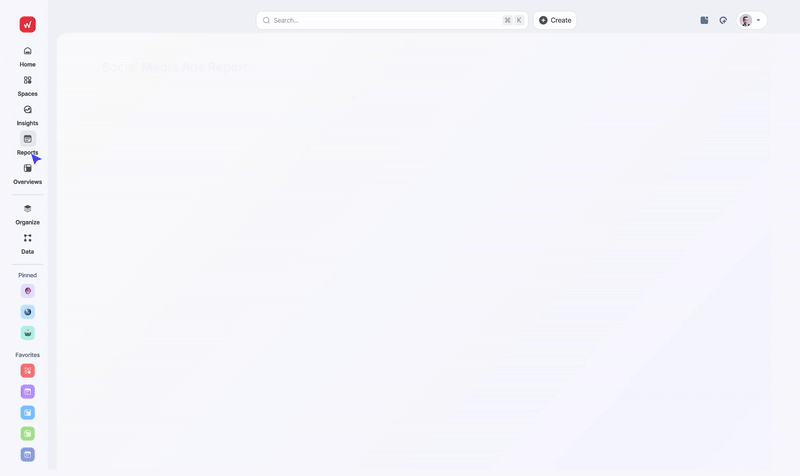
- IQ Themes: Upload a screenshot of your client’s or brand’s logo - or just type in a prompt - and Whatagraph instantly applies the fonts and colors across the entire report. You can still fine-tune the style yourself and save it as a “Global Theme” to re-use it the next time.
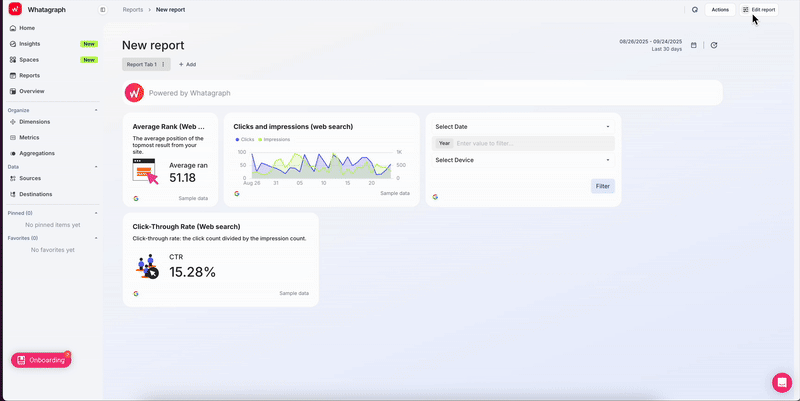
- IQ Summary: Tired of writing out performance summaries manually? Just get our AI to do it for you in 18 languages and five content types — Summary, Recommendations, Wins, Issues, or Custom Prompt.
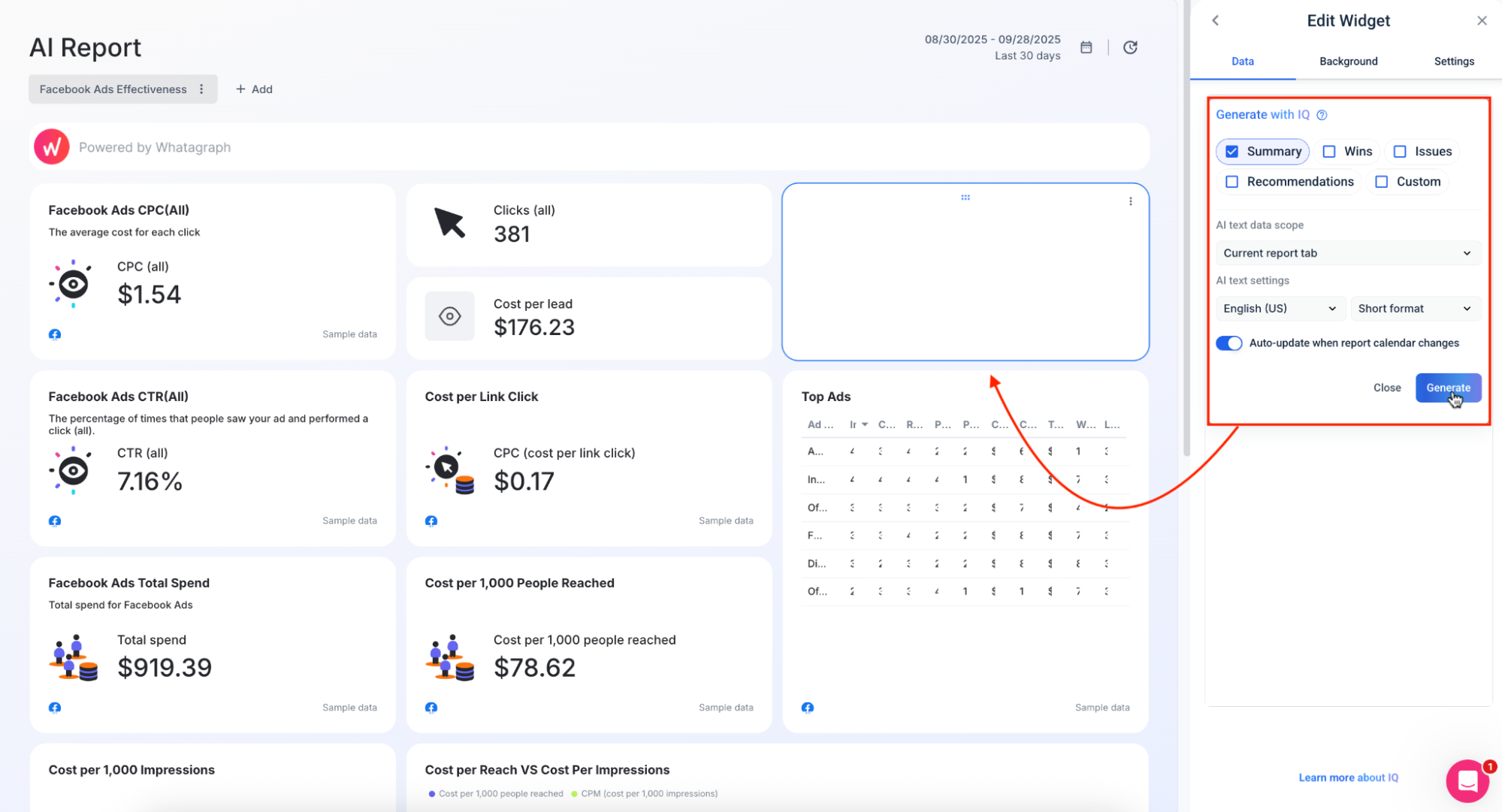
- IQ Chat: Need to answer a client’s ad-hoc question fast? Ask our IQ Chat (available inside of Whatagraph platform and inside a specific report) the question and get accurate answers based on your actual SEO data in seconds.
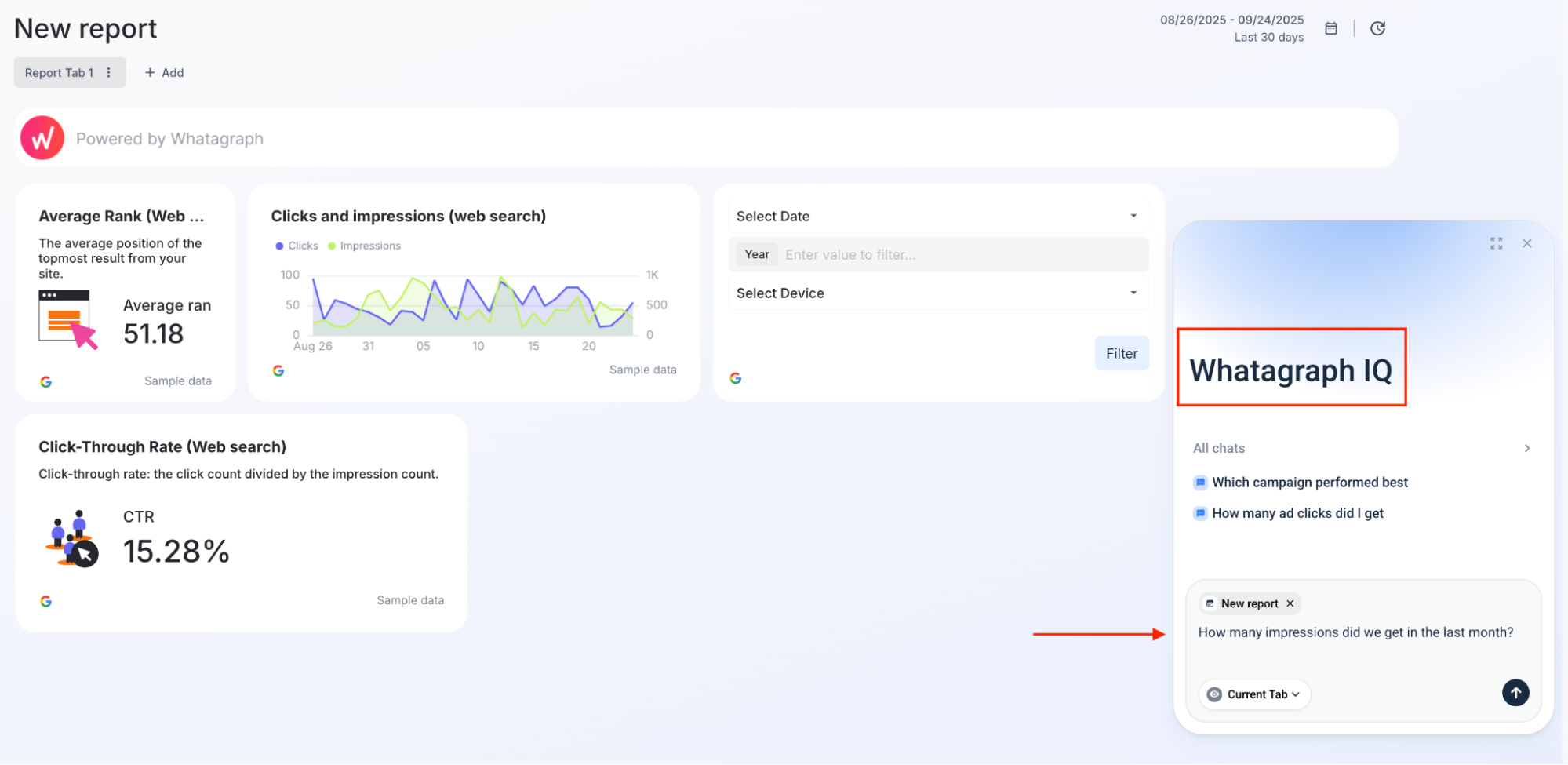
- IQ Dimensions: No more manually cleaning up your data. Just tell us what kind of new dimensions you want to build and we’ll do it for you.
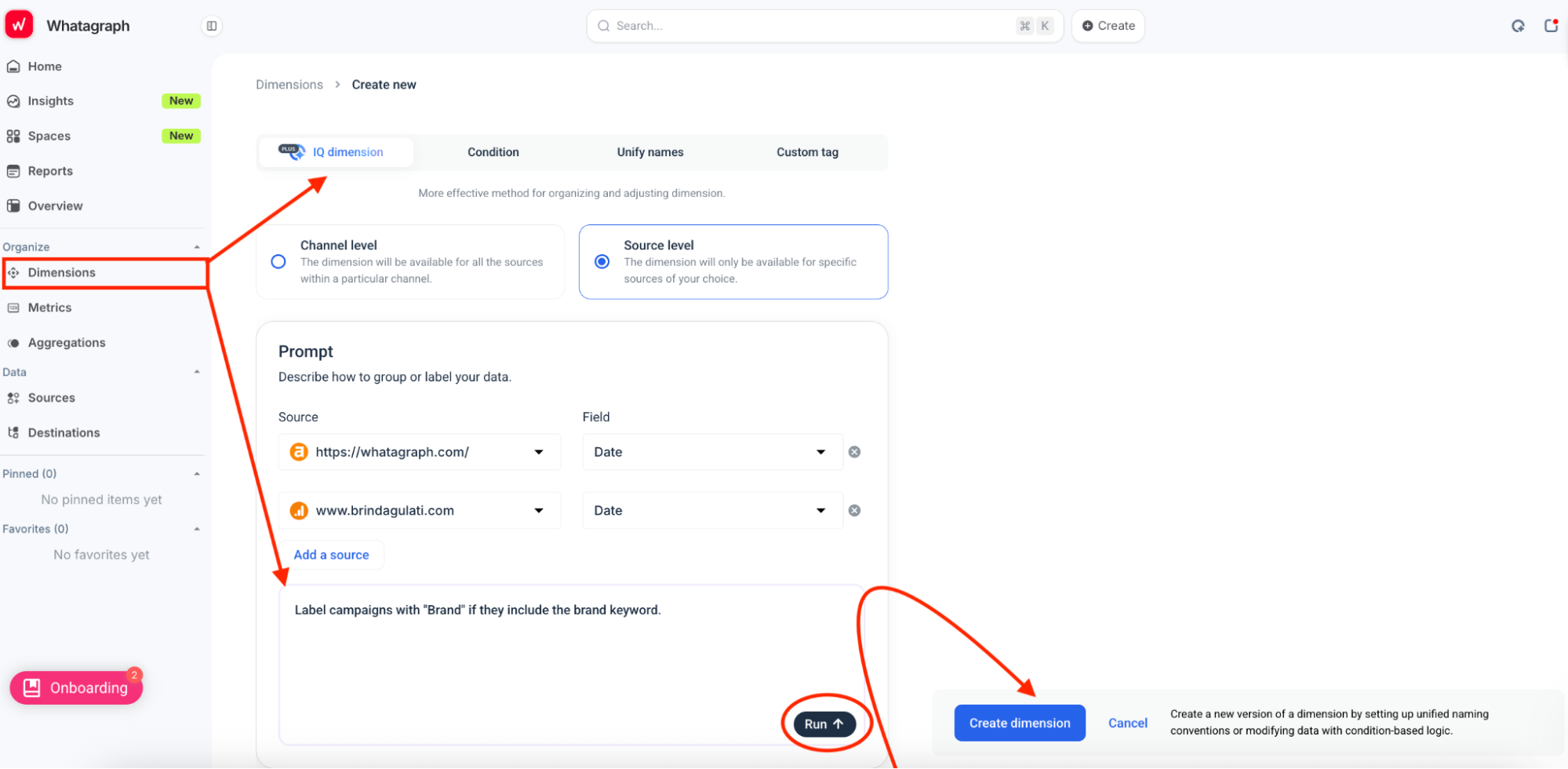
Thanks to these AI features, the team at Maatwerk Online is saving 100 hours a month on reporting. Here’s what Lars Maat, Co-Founder of the agency, has to say:
Whatagraph’s AI saves time and energy for our marketing specialists. And the hours we’re saving is just pure profit. We now have the time to focus on more strategic things that help both our agency and our clients grow.
Our SEO team built two main reports in Whatagraph that now act as our single source of truth during performance reviews:
1. Monthly SEO performance overview
This report pulls key data from GA4, GSC, Ahrefs, and DreamData—everything you need to see:
- Total Impressions, Clicks, CTR, and Average Position
- Keyword performance per page
- Blog post performance with metrics broken down by URL

Use this free SEO report template right away.
2. AI-referral traffic reports
This free AI report template tracks which LLMs (like ChatGPT or Perplexity) are sending us traffic—and which pages they’re sending it to.
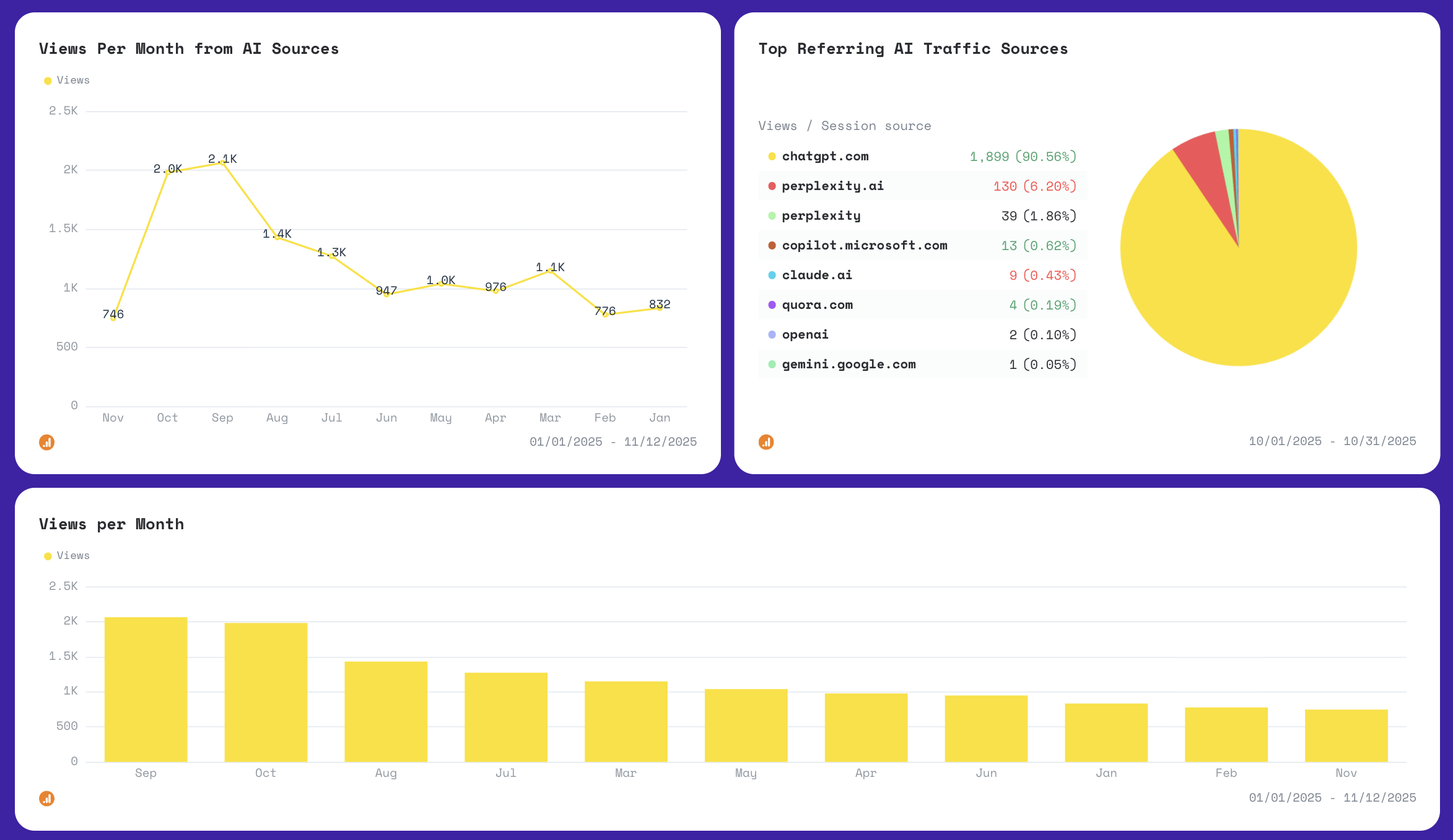
Want to see traffic from ChatGPT specifically? Use these templates for free:
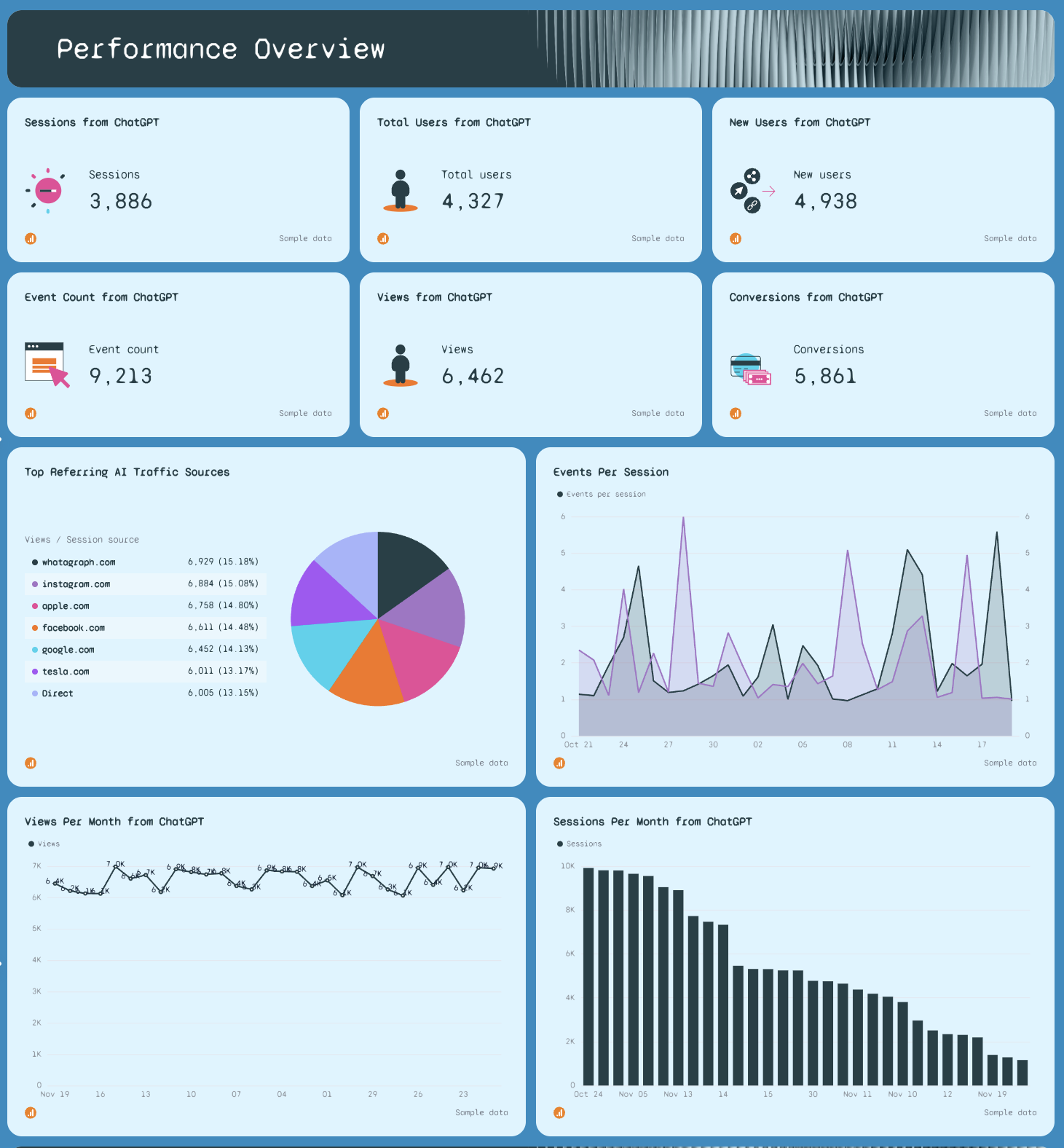
Alright, but how does Whatagraph work exactly and is it easy to use? I break it down below:
How Whatagraph works
1. Connect your data
Whatagraph pulls in data from all your SEO platforms—so you don’t need to jump between tabs or tools.
We support direct, stable integrations with both popular and niche platforms, including:
- Google Search Console
- Ahrefs
- SE Ranking
- Semrush
- Google My Business
- Google Analytics 4
- SEOMonitor
- AccuRanker
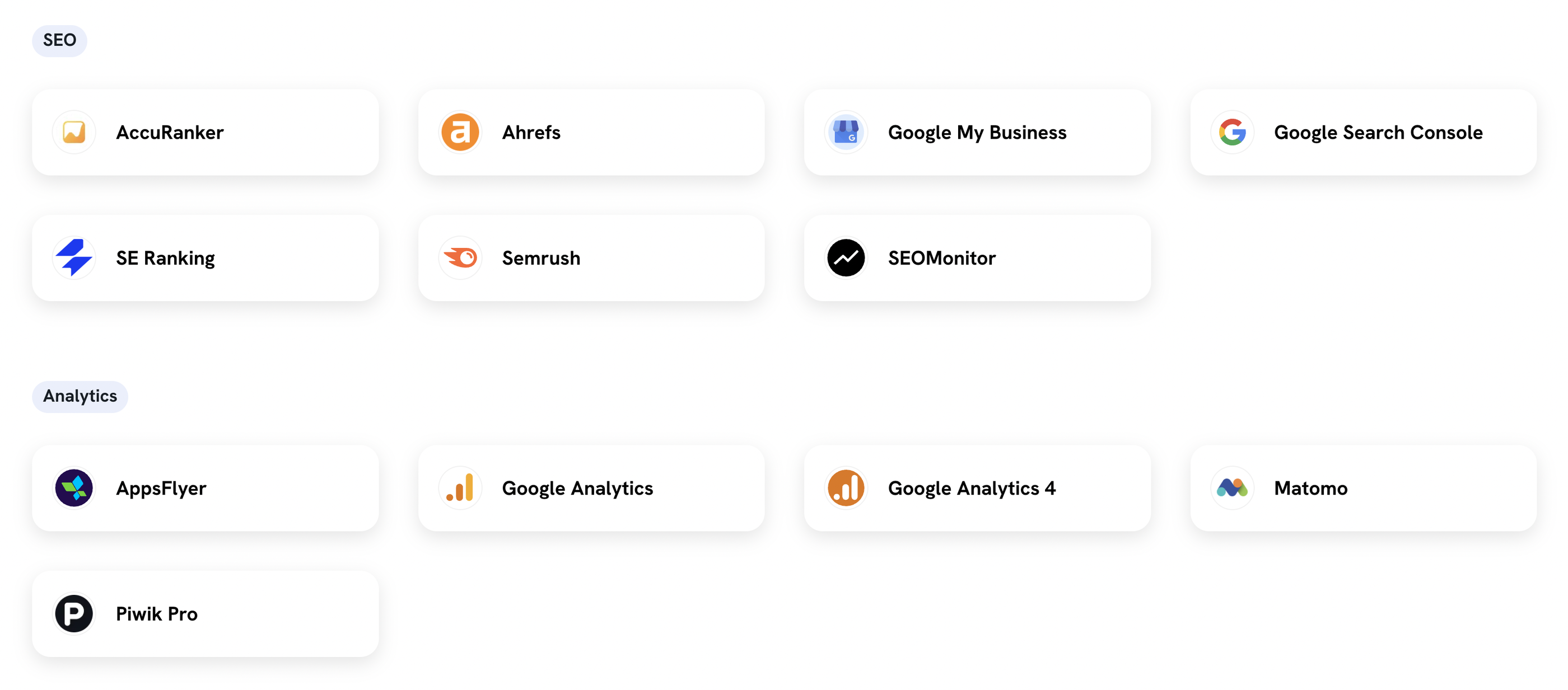 These integrations are all “one-click” – meaning you just need to click once, authenticate your account, and sit back and relax as the data flows directly into your SEO report.
These integrations are all “one-click” – meaning you just need to click once, authenticate your account, and sit back and relax as the data flows directly into your SEO report.
Once connected, data refreshes every 30 minutes across all integrations—no need to manually refresh your reports or wait for data to come in.
Bonus: Whatagraph isn’t limited to SEO. You can plug in paid media, email, and CRM platforms, too, making it easy to build full-funnel marketing reports in one place.
2. Organize and blend your SEO data
Once your sources are connected, Whatagraph gives you the flexibility to blend, merge, and standardize your data across platforms.
Here’s an example:
- Pull keyword ranking data from Ahrefs
- Combine it with organic traffic numbers from GA4
- Match those with goal completions or assisted conversions
Now you can see which keywords not only drive clicks, but also bring in high-converting traffic.
You can also blend blog post-level performance across platforms.
Want to know which articles have declining search traffic but growing backlinks? Or which posts rank well but don’t convert? You can do that—all without touching a spreadsheet.
It’s especially useful for SEO content audits, where you want to map visibility + engagement + conversion data in one place.
3. Visualize your data in stunning reports in minutes
You don’t need to have long, excruciating onboarding calls with the Support team to build your first report on Whatagraph.
Even the least tech-savvy person on your team can easily create reports using Whatagraph IQ or our ready-made templates.
With Whatagraph IQ, all you need to do is:
- Connect your data source (e.g. Google Analytics)
- Type in a prompt—the more specific the better (e.g. create an SEO report with X, Y, Z)
- Wait a few seconds for us to generate the report for you
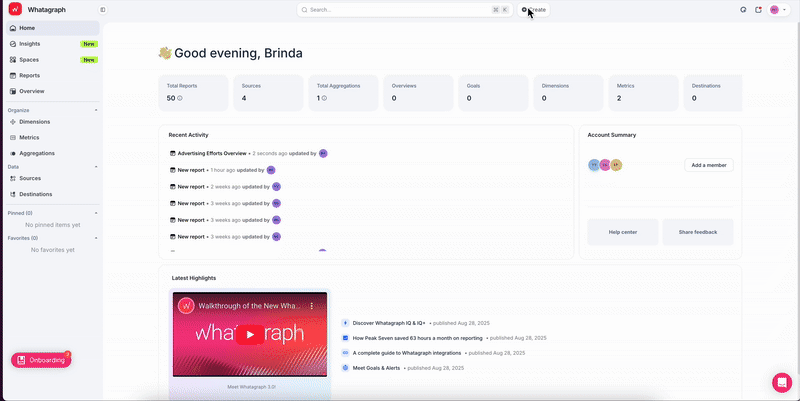
And wham bam, you’ll get a fully fleshed out SEO report.
From there, you can apply custom themes in seconds in two ways:
- Uploading a screenshot of your or your client’s brandbook or website
- Type in a custom prompt (e.g. “make the report look like a Batman movie”)
Whatagraph automatically detects the fonts and colors and applies them to your reports instantly. You can still fine-tune them manually, and once you’re satisfied, save the style as a “Global theme” and re-use it for other reports.
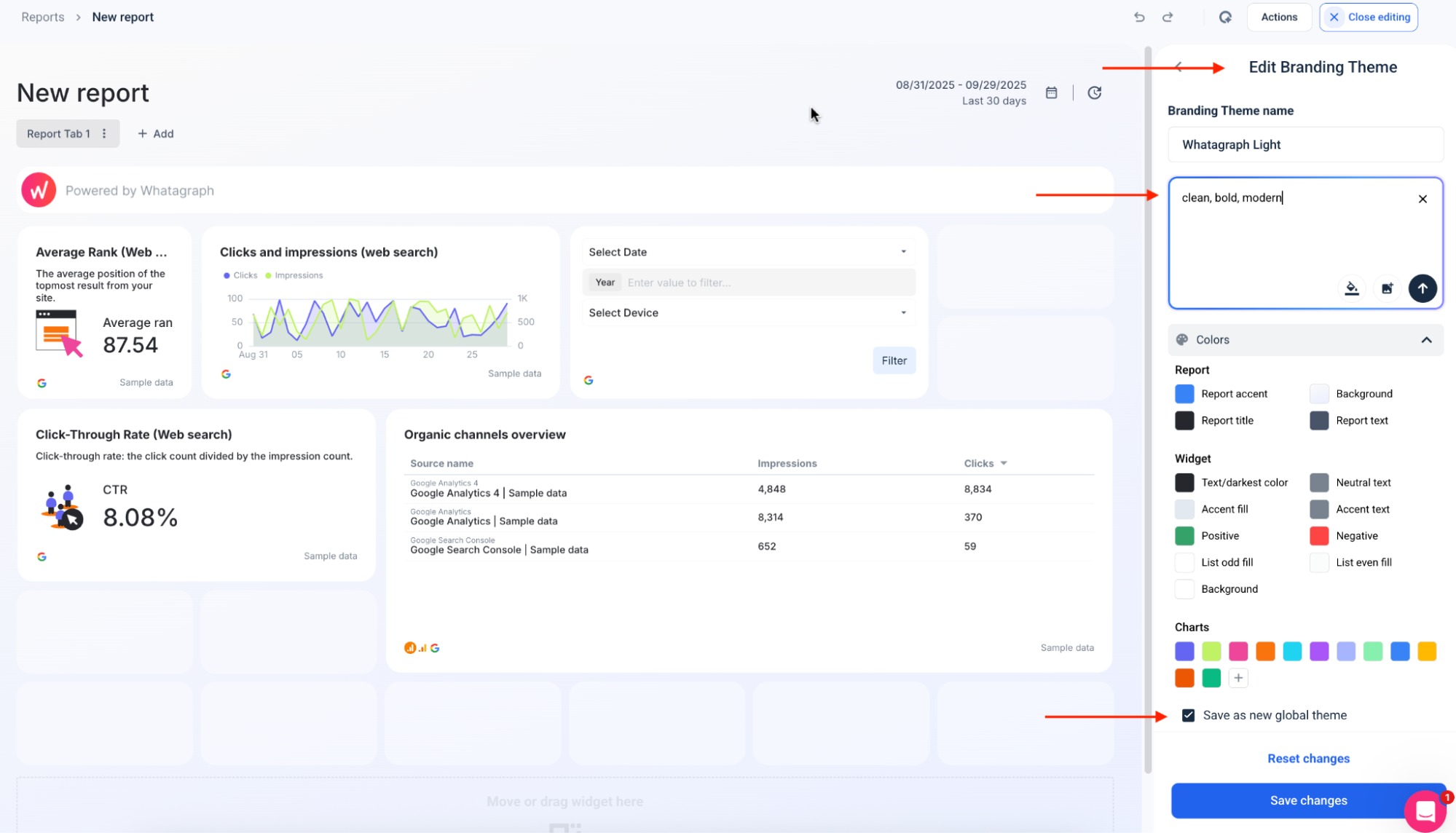
These reports are also fully-customizable. You can:
1. Edit titles, descriptions, currencies, and color themes of widgets
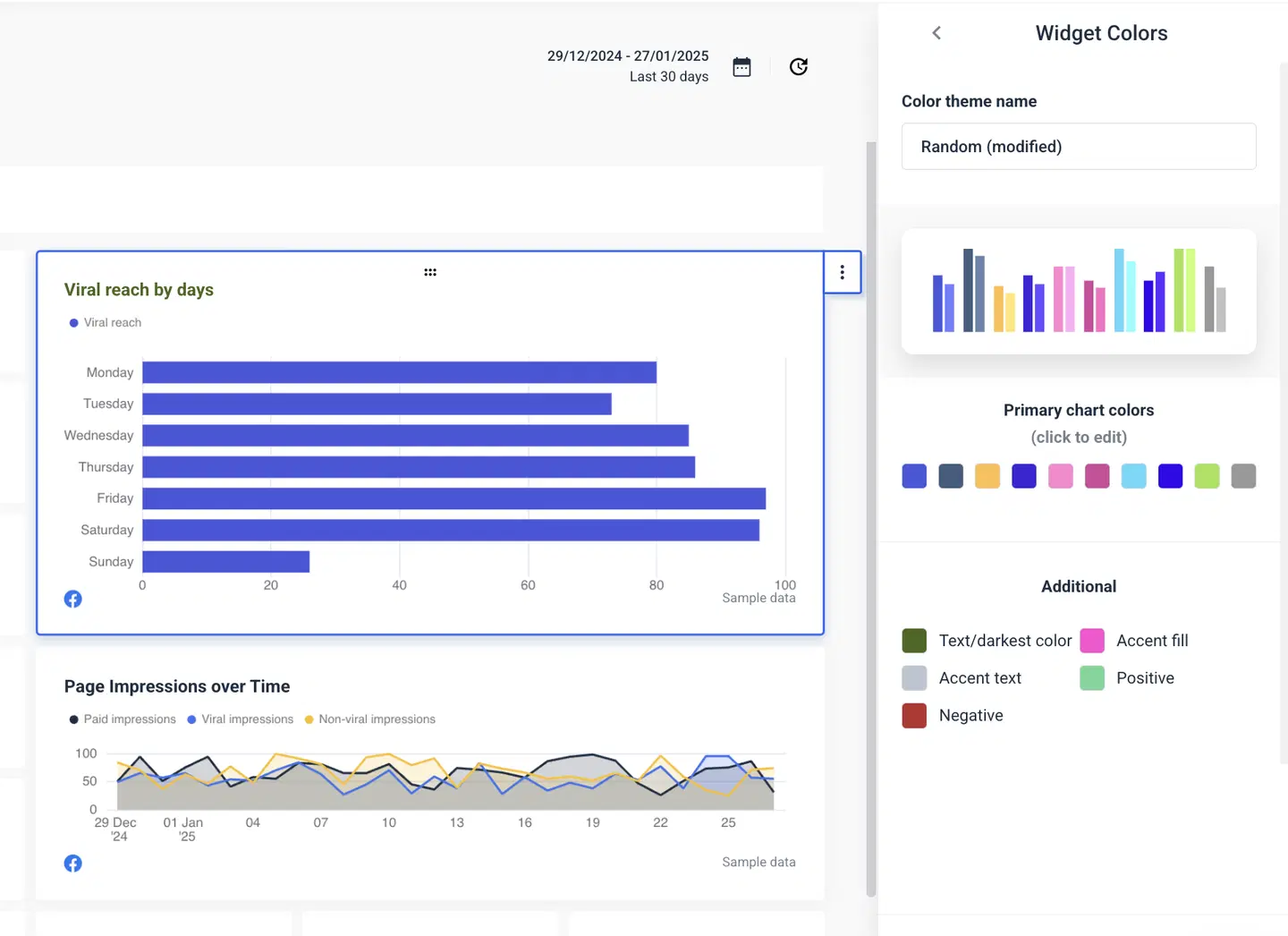
2. Choose any icons you want from our icon library for each widget
![]()
3. Insert or delete rows anywhere on your report
 This customization is what Stef Oosterik, Quality Manager at Dtch. Digitals agency loves about us. He said:
This customization is what Stef Oosterik, Quality Manager at Dtch. Digitals agency loves about us. He said:
Whatagraph is easy to use, visually attractive, and much smoother compared to tools like Looker Studio. It helped us not only get clients on board but also keep them within the agency.
Plus, to make it easier for you to edit reports, we have a feature called “Linked reports”.
Say you have a specific SEO report template that you use across 10 different clients, and you want to tweak that report a bit (e.g. change a widget icon).
Instead of having to edit the 10 different reports indivdiually, you can just:
- link these reports to the “master” template
- edit the “master” template
- and changes will sync automatically across your 10 reports
This can save you massive time and brainspace.
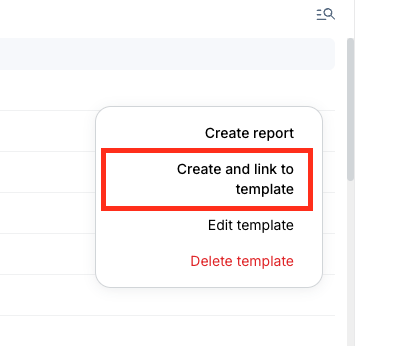
4. Share reports with clients or executives
Once your report is ready, you can send it out in multiple formats depending on who needs it and how they prefer to read:
- Automated email reports: Schedule weekly, monthly, or quarterly reports automatically.
- Live links: Great for clients who want real-time visibility into their performance
- PDF exports: Useful for board reports or executive summaries
- Excel exports: For the data-driven folks who want to dig deeper
Set reports to send automatically or manually review before sending. And if you spot any issues (like a drop in traffic or an error in the data), Whatagraph lets you pause the report and fix it before it goes out.
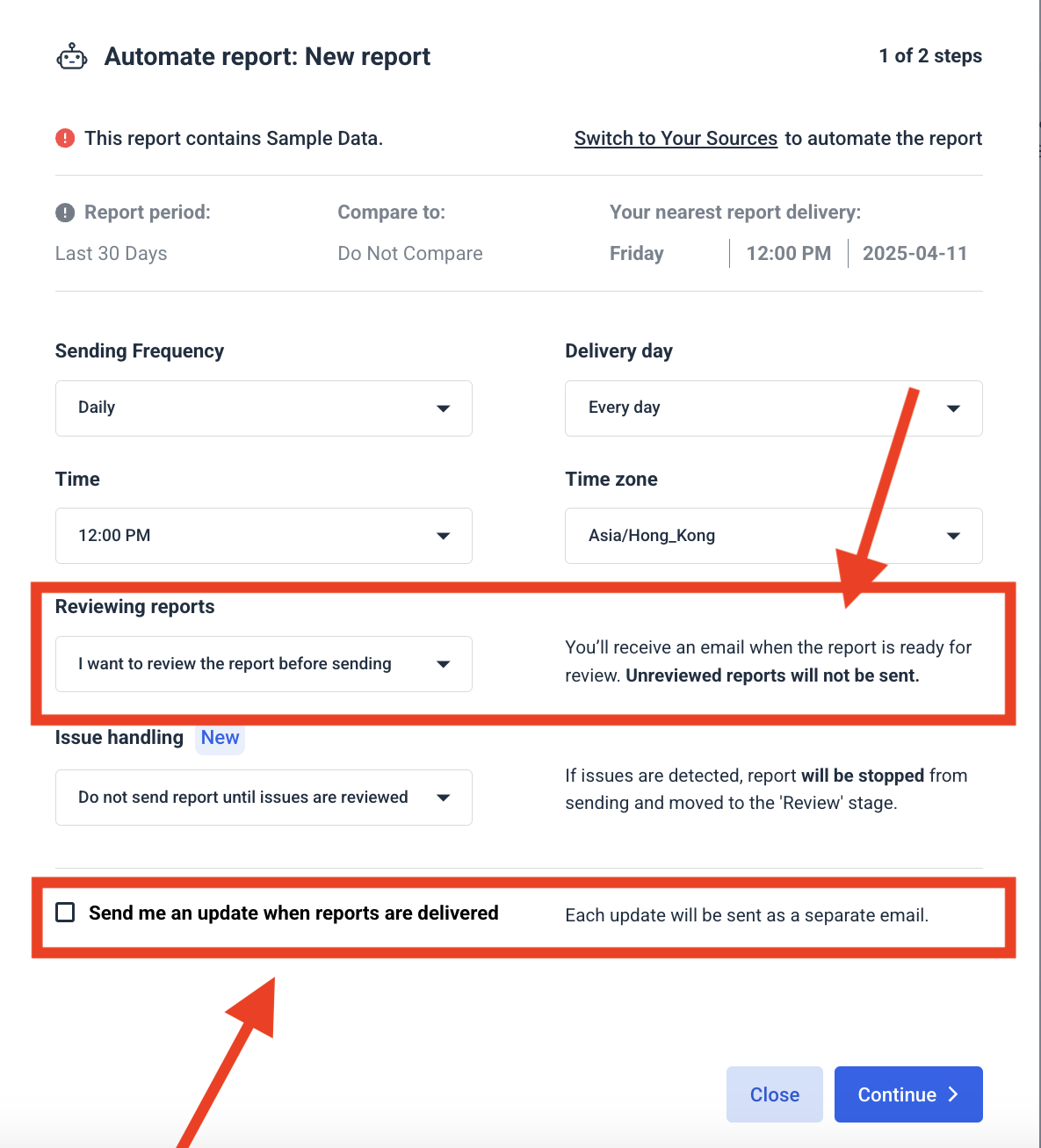
You also have the option to toggle IQ Chat on for your report reader. This will let them ask quick questions about the data on the report and get back quick answers—perfect for building trust and transparency.

Key features
- One-click integrations with 55+ marketing platforms
- Live data refresh every 30 minutes
- Cross-platform data blending
- Custom, interactive, client-branded reports
- AI-powered report generation, branding, summaries and insights
- Pre-built SEO templates
- Automated report delivery and alerts
Pricing
Whatagraph keeps pricing simple with three main plans:
- Free: A forever-free plan to test the platform with limited credits.
- Start ($229/month, billed annually): For small teams consolidating multiple accounts. Includes 20 source credits, essential integrations, pre-made templates, Whatagraph IQ, and live chat support.
- Boost ($579/month, billed annually): Best for scaling agencies working with advanced data sources. Includes 60 source credits, advanced integrations, white-labeling, performance overview dashboards, custom data transformations, and a dedicated Customer Success Manager.
- Max (Custom pricing): For large, complex reporting setups. Includes 100+ source credits, premium integrations, advanced data aggregations, Whatagraph IQ+, SSO, tailored onboarding, and priority support.
All plans come with:
✅ Unlimited users
✅ Unlimited reports
✅ Full access to Whatagraph IQ (Report Creation, Themes, Summary, Chat, Dimensions)
✅ Automated report sharing (live links, email, PDF, XLS)
Start free with Whatagraph today.
8. DataforSEO
Best for: Pulling real-time SEO data at scale to build custom tools, dashboards, or reporting workflows.
DataForSEO is a pay-as-you-go API platform that gives you direct access to raw SEO data, so you can build, scale, or power up your own tools.
It gives you real-time access to search engine data, keyword metrics, backlink profiles, and more, so you can build custom SEO workflows without the overhead of maintaining complex data pipelines.
It’s a great alternative to more expensive SEO analysis tools like Ahrefs and Semrush. Instead of paying for them, you can build your own tool with DataforSEO.
Samantha North, an AI automation specialist for B2B service businesses, built a competitor analysis workflow using DataforSEO API and Make, a no-code workflow development platform. She said:
I’m a recent fan of the DataForSEO API. I’ve been using it within Make automations for tasks like keyword research, competitor analysis and backlink analysis. It’s a super affordable alternative to expensive tools like Ahrefs.
This is how the workflow looks like:
- Starts with a Google Sheet containing competitor URLs
- DataforSEO API extracts important information like:
- Number of backlinks
- Referring domains
- Estimated traffic
- Number of top keywords, and more from the URLs
- Then, it updates the Google Sheet with all this info.
David Melamed, Founder at Ten Fold Traffic SEO agency, even "canceled" his Semrush & Ahrefs subscriptions, and now does all his marketing research and work in Codeium, an AI-powered coding assistant, using DataforSEO APIs and Google Cloud Project Credentials.
You can read more about the workflow he built in this LinkedIn post.
However, under that same post, Suman Chatterjee, SEO & Content Consultant at Brain Room Media agency warns:
You should check if DataforSEO data is accurate. I checked the traffic stats once and it was lagging behind Ahrefs. And data is what matters above everything.
How it works
DataForSEO provides a range of APIs that allow you to:
- Access SERP Data: Retrieve structured search engine results from Google, Bing, and other platforms.
- Conduct Keyword Research: Obtain keyword suggestions, search volumes, and competition metrics.
- Analyze Backlinks: Gather data on inbound links, referring domains, and anchor texts.
- Monitor Rankings: Track keyword positions across different locations and devices.
- Extract Business Data: Collect information from business directories, reviews, and local listings.
These APIs can be integrated into your existing systems or used to build new applications, providing flexibility and control over your SEO data needs.
Key features
- Full API suite for SERP, keywords, backlinks, and more
- Real-time access to search engine data
- Scalable for high-volume, enterprise-level use
- Easy integration across languages and platforms
Pricing
DataForSEO operates on a transparent pay-as-you-go pricing model:
- Minimum Payment: $50 to get started.
- API Costs: Pricing varies per API and usage volume. For example:
- SERP API: Costs depend on the number of requests and data depth.
- Keyword Data API: Priced based on the number of keywords and data points retrieved.
- Backlinks API: Charges are determined by the number of backlink records accessed.
9. Pitchbox
Best for: Automating backlink-building and outreach
Pitchbox is an all-in-one link building and outreach platform designed for SEO agencies, digital PR teams, and in-house marketers.
It streamlines the entire outreach process—from prospecting to personalized email campaigns—by integrating with top SEO tools and automating follow-ups.
Amit Raj, Link Building Specialist and Director at The Links Guy, a bespoke link-building agency, recommended Pitchbox to me. He said:
Pitchbox have some cool features where you can scrape datapoints from each target page (eg like H1, meta, H2’s etc) to bring into your campaign and then run multi prompts according to each one, and have that appear in the sidebar as you personalize your emails, or just have it make the personalisation for you.
He said this is useful for segmenting batches for link building or speeding up the personalization process. He also noted:
Would always recommend vetting it and editing before sending it out.
How Pitchbox works
Pitchbox automates and organizes your link building workflow in a few key steps:
- Prospect: Use advanced search features or import your own lists to find relevant bloggers, publishers, and influencers/
- Discover Contacts: Automatically fetch contact details, including emails and social profiles, for your prospects.
- Outreach: Craft personalized emails using SmartTemplates™ and schedule follow-ups with Natural Sending Patterns™ to mimic human behavior.
- Manage Campaigns: Track responses, monitor link placements, and manage your pipeline with a built-in CRM tailored for link builders.
- Report: Generate white-labeled reports to analyze campaign performance and share results with clients or stakeholders.
Key features
- Discover link prospects via keywords, competitors, and SEO tool integrations
- Automate personalized outreach with follow-ups
- Manage contacts and link status with built-in SEO CRM
- Use AI to personalize emails and replies at scale
- Track campaign performance with detailed reporting
- Integrate with Slack, Zapier, Looker Studio, and more
Pricing
Plan | Price/month | Best for |
| Pro | $165 | Small teams handling their own outreach |
| Advanced | $420 | Mid-size agencies with multiple clients |
| Scale | $675 | Larger teams scaling campaigns and team workflows |
| Enterprise | Custom | Enterprise setups needing API access, SSO, and support SLAs |
All plans include core features like outreach automation, CRM, prospecting, and campaign tracking. Higher tiers unlock more users, workspaces, and advanced customization.
10. Ranking Racoon
Best for: getting backlinks from authority sites
Ranking Raccoon is a community-based link-building platform that lets you connect directly with verified website owners to exchange backlinks.
Every site is manually reviewed, so you’re only seeing credible opportunities.
Unlike Pitchbox, which automates outreach emails at scale, Ranking Raccoon skips emails entirely and gives you instant access to verified SEO professionals who are actively looking to exchange high-quality links.
It’s like Tinder for backlink-building — you sign up via LinkedIn, add your site, and AI recommends the most relevant sites based on topical match so you see the best fits.
Then, you can immediately start a chat with the site owner. Ranking Racoon claims that their customers enjoy a 71% reply rate within a week, and 35% of that turned into published links.
It’s a more straightforward and dare I say, easier, way to build links without having to send cold pitches.
Siddharth Kushwaha, SEO Outreach Specialist at factoHR, said:
Ranking Raccoon is an underrated one. It's an interesting and viable option for young and aged domains to build relevant and quality links by directly connecting with site editors. They're improving the platform little by little, and I'm loving it so far.
But also, I imagine the success of link building on Ranking Raccoon greatly depends on:
- How big their community is
- How good of a quality the sites on there are
Fortunately, you can check it out for yourself with their 7-day free trial.
How Ranking Racoon works
The process is quite simple.
- Sign Up via LinkedIn: Ensures a community of verified SEO professionals.
- Browse Verified Sites: Access a curated list of websites across 54 industries.
- Direct Messaging: Initiate conversations with site admins to propose link exchanges.
- Link Confirmation: The platform automatically verifies when a backlink is live and do-follow.
Key features
- Get backlinks from manually vetted, high-quality websites
- Avoid link farms with a strictly moderated, spam-free platform
- Verify backlinks in real time with automated checks
- Follow community guidelines that promote ethical link building
Pricing
As of May 2025, Ranking Raccoon offers two pricing tiers:
Lite (Free Forever):
- Add unlimited sites.
- Your sites are visible on Pro users’ dashboards.
- Get contacted by users interested in your sites.
- Build shareable profiles with link-building guidelines.
- Invite new site admins.
- Community guidelines ensure best practices for all users.
Pro ($25/month):
- Includes all Lite features.
- Browse and filter verified sites in 54 industries.
- Start unlimited new chats with other link builders.
- Your sites are visible on Pro users’ dashboards.
- Get contacted by users interested in your sites.
- Build shareable profiles with link-building guidelines.
- Invite new site admins.
- Community guidelines ensure best practices for all users.
11. Indexly
Best for: Automating indexing so your pages show up in search faster without manual submissions or waiting for crawlers
Indexly is an indexing automation tool that makes sure your web pages get discovered by search engines fast, without manual submissions or weeks of waiting for Google to catch up.
Instead of watching newly published pages sit in limbo, Indexly checks your sitemap, finds new or unindexed URLs, and submits them automatically to Google, Bing, and Yandex.
The result is faster indexing, faster rankings, and fewer missed opportunities for organic traffic.
Victoria Kurichenko, SEO Specialist and Content Writer at Self Made Millennials SEO agency told me:
I've been using Indexly as a technical SEO tool to help track and speed up indexing. What I like best is that the tool keeps improving. They’re adding new features like keyword rank tracking and on-page audits. Honestly, it’s on its way to becoming an all-in-one SEO toolkit.
How Indexly works
1. Auto Indexing (Set it and forget it)
- Connect your Google Search Console account to let Indexly detect your sites and sitemaps
- Select the websites you want to monitor
- Indexly scans your sitemaps every 24 hours
- It finds pages that aren’t indexed or failed with errors, then submits them automatically
- You get email notifications on status and indexing updates
2. Instant Indexing (Manual control when you need it)
- Submit individual or multiple URLs instantly—no need to log into Search Console
- Save hours of manual work, especially if you’re updating lots of content at once
- Ideal for high-priority content, launches, or content refreshes you want live now
3. Performance Analytics
- See which pages are getting impressions, clicks, and CTRs
- Identify what’s ranking—and what’s not
- Understand which keywords are driving traffic so you can double down on what works
- Use insights to fine-tune your content and indexing strategy in real time
Key features
- Auto-index new and updated pages daily via sitemap scans
- Manually submit pages for instant indexing in search engines
- Bulk-submit URLs to save time on large updates
- Track impressions, clicks, and CTR with built-in analytics
- Monitor keyword rankings and get alerts for changes
- Check and track live backlinks contributing to SEO
- Submit content to AI engines like ChatGPT and Perplexity via Bing integration
Pricing:
Indexly’s pricing plans are quite affordable, making it perfect for freelancers and solopreneurs:
Plan | Price/Month | Features |
| Free Plan | $0 | Yandex indexing, instant and auto indexing, page inspection. 14-day trial for premium features. |
| Solo Plan | $14 | 3 sites, Google and Yandex indexing, 200 submissions/day, analytics, keyword monitoring. |
| Team Plan | $39 | 10 sites, 400 submissions/day, bulk indexing, backlink audit, LLM indexing tools. |
| Business Plan | $79 | 20 sites, Google, Bing, and Yandex indexing, 600 submissions/day, advanced analytics. |
6 Bonus AI Tools to Help SEO
Here are some more tools that SEO strategists on LinkedIn recommended, but I didn’t have enough time to test and review them all:
- Linknavigator — an internal-linking automation tool for Webflow
- Yahini — an AI content strategy tool that learns from the SERPs and your business to deliver customized content briefs and keyword strategies
- RivalFlow AI — content gap analysis tool that tells you exactly what your underperforming content is missing based on real SERP competitors
- Narrato — AI content workspace that helps you plan, create, optimize, and manage SEO content at scale
- Postaga — an outreach tool that helps you find link opportunities and automate personalized email campaigns to build backlinks faster.
- Apify — backlink building agent that finds relevant pages and websites, extracts contacts from them, and creates personalized outreach sequences
Want more tool recommendations? Check out our guide on SEO reporting tools for agencies.

WRITTEN BY
YamonYamon is a Senior Content Marketing Manager at Whatagraph. Previously a Head of Content at a marketing agency, she has led content programs for 5+ B2B SaaS companies in the span of three years. With an eye for detail and a knack for always considering context, audience, and business goals to guide the narrative, she's on a mission to create genuinely helpful content for marketers. When she’s not working, she’s hiking, meditating, or practicing yoga.